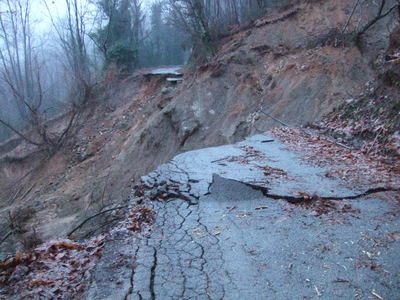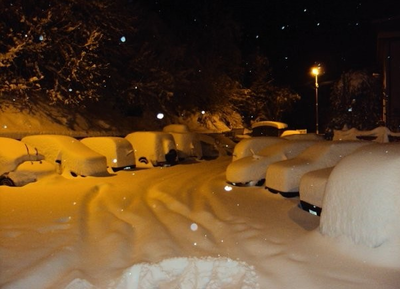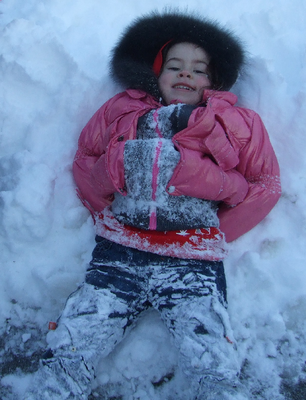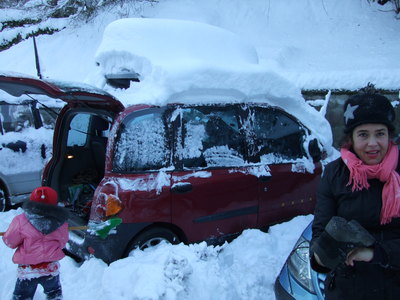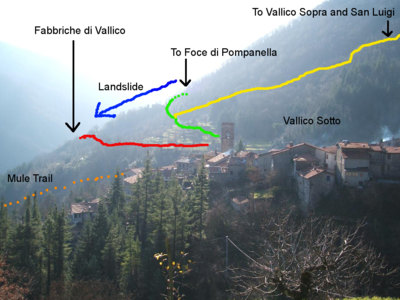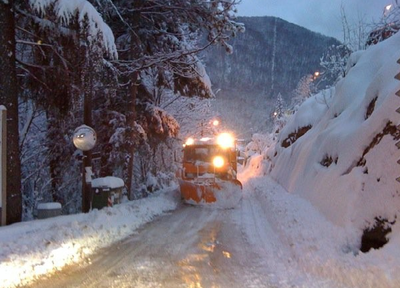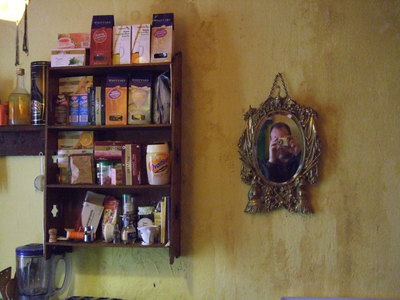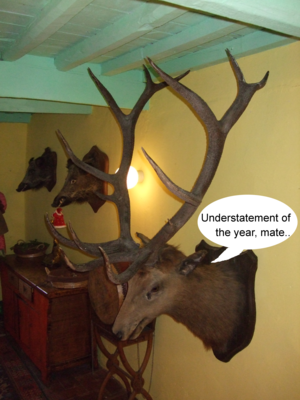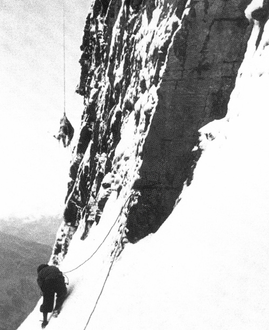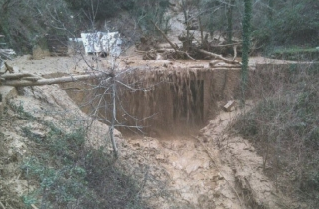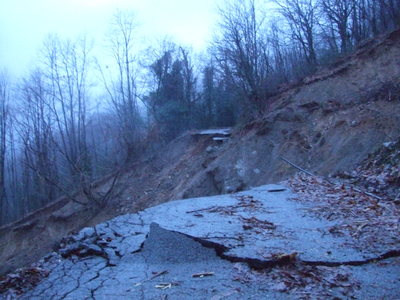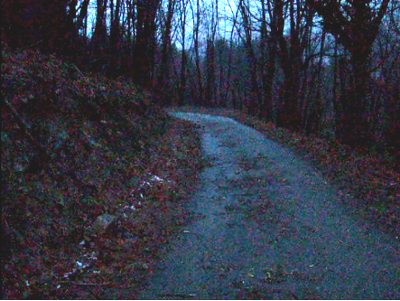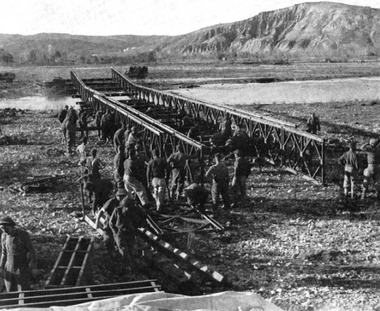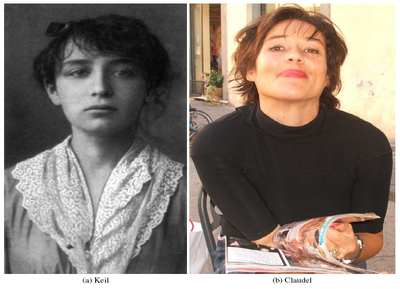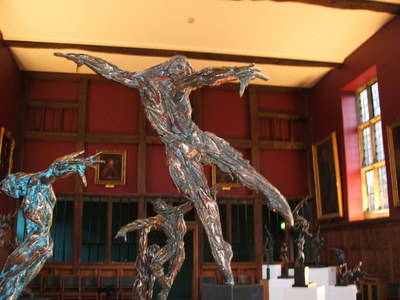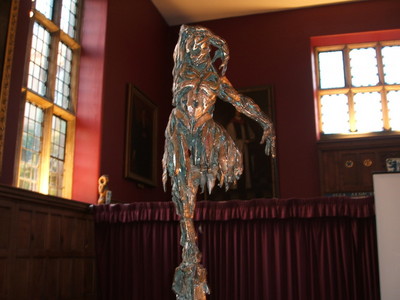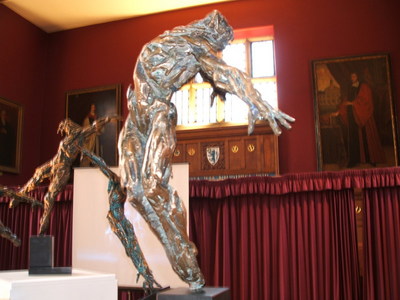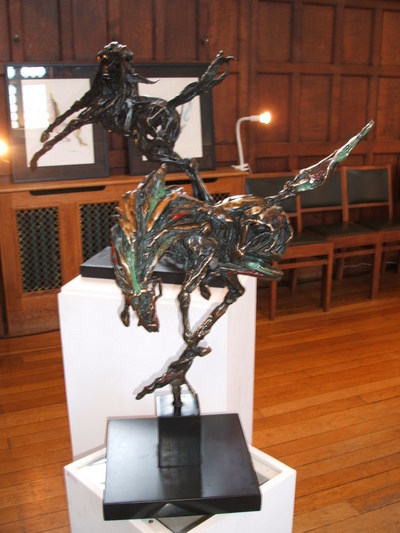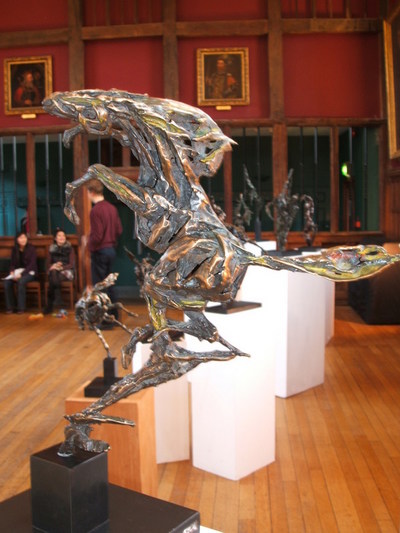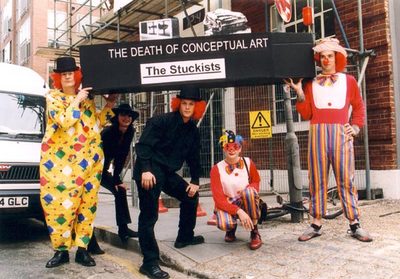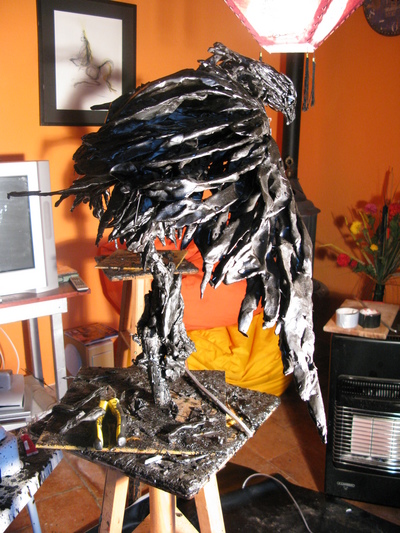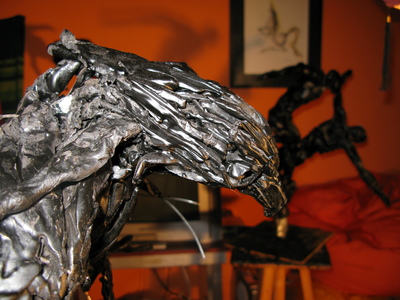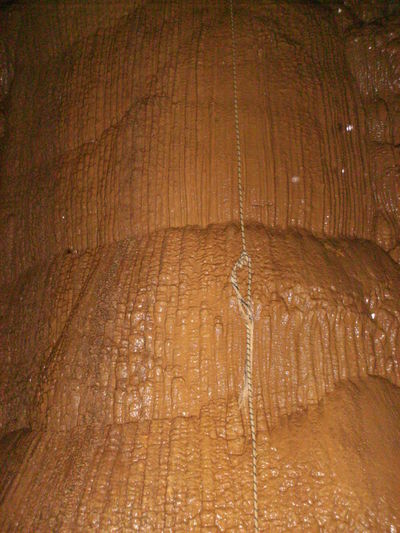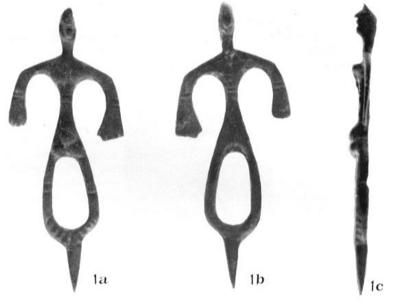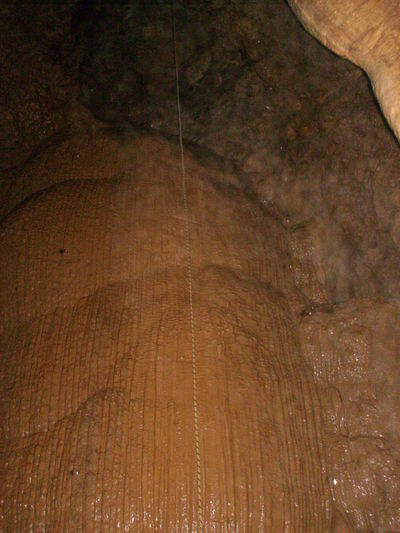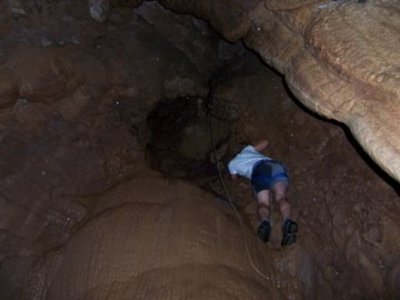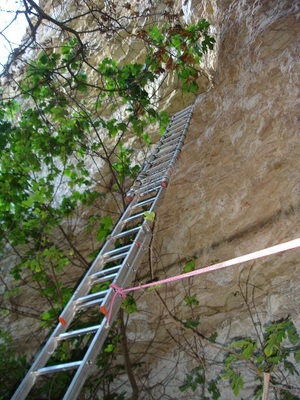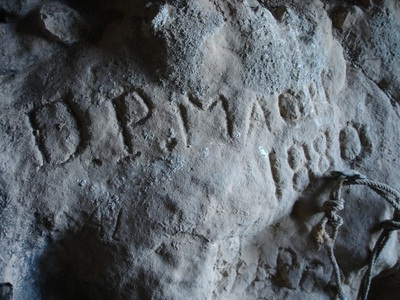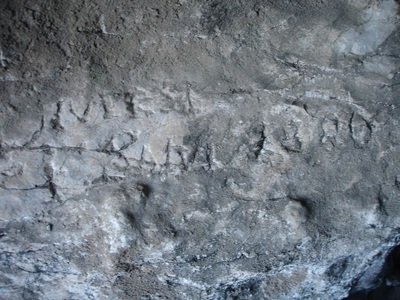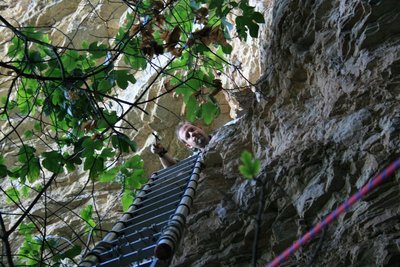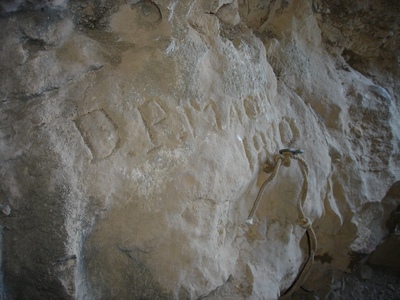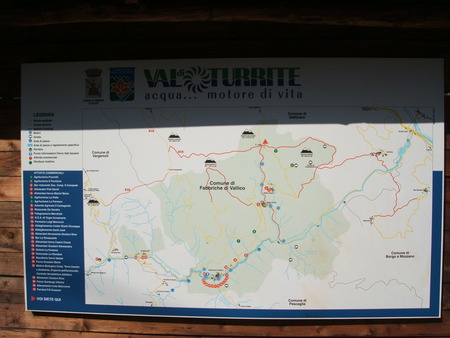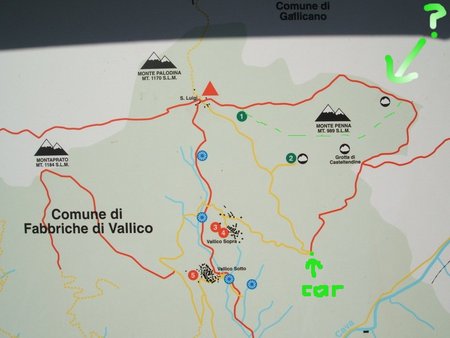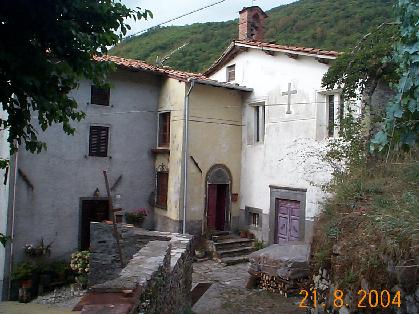Here for the readers of the CASINOQMC site, in reverse order of publication, are five stories originally published in the ‘News from the Towler Institute’ blog on that wonderful website barganews.com [‘busily putting Barga on the map’ with single-minded determination since 1996 – before most people had even heard of the internet – by Keane, a great man and a great artist]. The stories concern various happenings during the development of the Apuan Alps Centre for Physics which may be of interest to people who have attended events at the venue.
Tales from the Disaster Zone
by Mike Towler
So we’re cut off. Vallico Sotto is isolated from the rest of humanity by the biggest damned landslide you ever saw. See this hundred-foot-deep three-hundred-foot-wide mile-long hole? That was a road I walked over just the day before.
It all began with the snow, see. They cancelled the school bus because of the nasty weather, and so I took Froggie the Fiat Multipla down to pick up our four-year old daughter Saska and the three daughters of some English friends who live in the forest below Vallico. It’s the week of the recita – which I imagine is some kind of Nativity play – and Saska has been given the vitally important role of a snowflake. It’s not what I’d hoped for actually. Especially since at the big pantomime in her English school a week earlier she played a star, not in the showbiz sense, but in the sense of standing at the back of the stage with a gold pointy shape attached to her head and being told to twinkle. You’ve got to say it’s disappointing.
I’ve got the Virgin Mary in the back of the car though. And to be fair you can see why she got the job, as she looks exactly like your internal picture of the real one back in about 10 BC, albeit maybe a bit cleaner. And right now, you can tell from her face she’d rather be on the back of a donkey than in my car. The school is down in the valley far below, and when I got there it was only pretending to snow. As we begin the climb back up the steep, winding road to Vallico Sotto, it really starts to snow. Proper snow that sticks to the road. And Froggie, with his old worn-out wrong-sort-of-tyres and total lack of preparation for winter, starts to slip and slide. After ten minutes of incredibly slow driving in second gear we get back to the Vallico car park and I reckon we have something like five minutes to spare before the road becomes impassable. Lucky.
The Virgin Mary’s father – sadly called John rather than Joachim – is waiting, and he hurriedly clears off to his forest with the short-arsed holy trio. Saska, my wife Sammy and I are left alone in the car park. Through the swirling snow I gaze at the ugly monstrosity building site which has been the public face of Vallico for the last three and a half years. When we first came here five or six years ago, it was a beautiful old ruined fourteenth century palazzo. Looked quite nice actually. Only reason you couldn’t live in it was that there was no glass in many of the windows and there was a huge crack in the stonework of the facade. Then whoever owns it decided to restore it by – get this – completely demolishing it then putting the resultant jigsaw back together from the multiple piles of tens of thousands of ancient stones. Unsurprisingly this took a long time, with a giant crane taking up half the places in the car park, but eventually something that looked remarkably like a modern palazzo reappeared. No plaster, still no windows, and then everything stopped. People said that the builders had been banged up in jail for nicking the most architecturally important bits of masonry and selling them on. Some other people said the money had run out. Eventually after a year or so someone came and took the crane away (What’s the weekly rent for one of those things? No wonder they had financial problems.). And so now for a hell of a long time an unfinished something like you’d expect the Mafia to build in Sicily has squatted like a monstrous toad in front of our supposedly-protected beautiful village, amid piles of mud and concrete, swathed in scaffolding and the ugly bright-orange netting with which the law obliges you to cover every building site. The hundred or so people I bring here every summer for our public events arrive expecting to see some kind of Tuscan mountain idyll. When they get here and see this thing it’s clear some of them want to go home again. On the official building site sign where it says “Estimated Date of Completion: Dec 2007″ someone has written, in Italian, “So f***ing complete it then”. That’ll be the day.
So, slipping and sliding just like Froggie, we walk up the steep path to our lovely old monastery and settle in for the night.
Fast forward to the following morning. After I wake up, I lie in bed for something like four hours, refusing to tunnel from underneath nine layers of bedclothes into the frigid air of my unheated room. When I eventually crack and fling open the frozen shutters, all I can see is a vast uneven field of snow extending as far as the eye can see; the unevenness is caused by a series of giant lumps which I take to be houses. The entire village and all of the surrounding mountain have been completely buried under two to three feet of snow. We are, and not for the last time this Christmas, cut-off from the rest of the world. When I pop next door later, our lovely neighbour Flora Calissi – a resident of Vallico Sotto since around 1896 – told me there hadn’t been any serious snow up here since the 1960s. Before that, she said, it was a regular thing; that’s climate change for you. To be fair though, a couple of the younger local lads (the ones in their 70s) remembered that actually there was a pretty fair snowfall here around 1985. Mind you, that’s still a quarter of a century ago and you have to wonder whether the council snowplough still works.
OK, snow. Brilliant. Snowmen! Snowball fights! Let’s build an igloo! Hooray. However for some reason I don’t have any gloves and when the air-temperature is still around minus 10 degrees and the snow is exactly the wrong sort of powdery little crystals that don’t stick together you rapidly lose your enthusiasm after picking up your first handful. Unless you’re Saska of course. She quickly goes completely mental and buries herself in the stuff for hours on end and amazingly emerges without a terminal case of frostbite..
Back in the world of grown-ups, there are problems. Just around the time of the first snowfall Sammy and I realized there wasn’t any food in the house, and we were just about to plan an expedition to the big Leclerc supermarket in Gallicano when the snow came. So now we’re likely to be stuck here for days with nothing to eat. Now, why don’t we just go to the local shop, you might ask? Well, first of all of course, Sammy’s got to have her bloody soya milk and other rare delicacies that they don’t stock in village shops – Christ, there’d be tantrums if she was stranded on a desert island – but the most important point is that we don’t have a village shop any more. We used to, mind, but sadly it closed a few years back when local baker Mario – husband of the lovely Adelina from behind the counter – built a giant new emporium for her down in the main valley miles away. If you visit Da Mario in Piano di Coreglia, tell them to come back. We miss them. There was a village restaurant too, but that closed a few years before the shop did. There is still a bar, but it’s a sort of members-only workin’ mens’ club (apparently so they don’t have to pay tax on the beer) and it’s not the sort of place you go to have fun in winter. So basically we’ve got no services left at all. When the villagers were offered a mains gas supply a year or so before we arrived they voted against it, on the grounds that Mario would always bring round the enormously heavy bombole di gas for your gas fires or your cookers on his little tractor, and these are apparently very slightly cheaper. Bet they’re regretting that now.
I should say though that everything in the restaurant is still there (tables, cookers and all that) – it’s just that the door is always locked. Some enterprising and very kind local friends of ours actually reopened it this year during one of our summer schools when we had our annual “Vallico Sotto against the World” football match and they made us some quality pizza. One little village – with only around eight guys fit enough to run around for half an hour – against a potential pool of something like seven billion people. I’ve tried importing Brazilians, English, Spanish, Germans. Even Mongolians and Nepalese. But it’s no use. Every year we still get hammered by Marco and his boys. The shame of it.
Anyway, I digress. We’re trapped, and we’d better get used to it.
OK, so you don’t get confused with what follows, let me bring you up to speed with the local geography. The fortress and village of Vallico Sotto – which certainly dates back to Roman times (I’m currently translating Gabriella Carli’s history of the village – should be finished as soon as I can figure out what the lengthy passages of mediaeval Italian mean) – is built on the ridge of a rocky outcrop high in the southern reaches of the Apuan Alps between the two little rivers Rio Maggiore and Rio Selvano. A few hundred metres higher is our non-identical twin, Vallico Sopra – presumably built not long after Vallico Sotto when some sun-worshipping ancient from the Dark Ages realized that its location got sunshine for a couple of hours longer in the afternoon. This is where our artist friend Mandy lives, of whom you will hear more. She bought a ruin there last year, and the builders have just (like, two days ago) finished putting in the heating. She has – and she’s really going to regret this – invited about 200 members of her family to visit during this Christmas holiday to celebrate the completion of her new home. Mandy, husband Dave, and son Tom drove here from England and arrived about twenty minutes before me and the Virgin Mary and the others got back from school. That was lucky too.
How can we get cut off then? Basically, there’s one only way up.. Look at this photograph of what Vallico normally looks like in winter..
The red road is the escape route from Vallico Sotto (population: 120). Just on the other side of the ridgeline the road winds down for about three km past the Da Sandra restaurant as far as the village of Fabbriche di Vallico at the bottom of the Turritecava valley. Descending from there along the Turritecava river for about nine km brings you to the main valley of the river Serchio. From there, left to Barga and Gallicano, right to Lucca.
The green road goes past some local agriturismi and a few houses. Then the tarmac runs out and the resulting bumpy dirt road climbs steeply up to the ridge at Foce di Pompanella. In principle it’s possible to traverse this to get to the village of Trassilico in the next big valley parallel to ours, but in reality you need a four-wheel-drive off-roader with a three-foot ground clearance. Froggie doesn’t cut it. The yellow road goes to Vallico Sopra (population: 80) then continues up to the ridge where we find a dead end at the even tinier village of San Luigi (population: 10 and some dogs). There is in fact an old mule trail from there which continues to Verni and Trassilico but it’s completely impassable to cars, even expensive ones. That said, I reckon a hundred guys, working for a week, could widen it and clear it to make it suitable for motor vehicles.. Why would you need to do that, though? I mean, really! Don’t look at the blue line yet.
The orange dotted line is the mule trail. The lily-livered pansies like me who inhabit the place nowadays talk about being cut off, but you’ve got to remember that the red, green and yellow roads were only built from 1960 to 1970. Before then, if you wanted to come up here, you had to hitch a lift with a bloody donkey – for Christ’s sake – all the way up one of the mule trails now overgrown and forgotten by everyone but the very old. Didn’t stop ‘em though. There were getting on for a thousand people living up here in the early 1900s.
Just for the record, this is what Vallico looked like a few days after the snow. Reminds me of the hymn we used to sing at school back in the 1970s (though obviously these days you’re not allowed to sing hymns, since Jesus was after all only a minor prophet and you might offend someone):
Earth stood hard as iron, water like a stone;
Snow had fallen, snow on snow, snow on snow,
In the bleak midwinter, long ago.
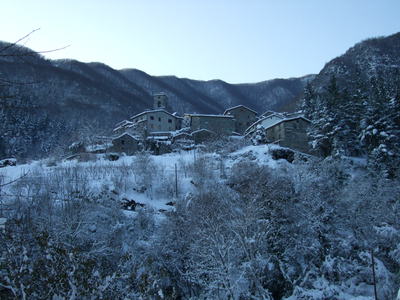
So anyway, we stick it out for three or four days. We venture out occasionally to play around in the snow, but mainly we sit inside, reading, talking, playing. The girls watch about 8 million DVDs. Yeah, and we cook as well. Real back-of-the-cupboard stuff. It’s when I find myself looking one evening at a bowl of two-year-old rice to which – in the absence of other options – I have just added some red-wine vinegar and a pinch of cinnamon past its sell-by date, that I realize this is starting to piss me off. Not only the food, but the water pipes have frozen, and we can’t wash, clean our teeth, flush the loo, and the only reason I was able to cook the rice was because I melted some snow. It would be good to know when we can get out of the house for a bit. I want to take the girls to Lucca, to let Saska play on the vintage roundabout with horses that go up and down. I want to mooch around the Christmas market, to visit the antiquarian bookstore, to sit in our favourite little bar sipping some deep rich red wine. Vallico Sotto is great, but a guy’s got to have a little relaxation. And anyway, I don’t have enough presents to fill Saska’s Christmas sock.
The council have fired up the rusty old snowplough, sure enough, and they’ve cleared the roads. But they’re all still covered by a thick crust of ice and Froggie has no chance of even getting out of the car park. But it’s then that something bad happens. The temperature goes up by more than twenty degrees in the space of a few hours. What do you call it? A warm front moves in. And then. And then about five billion tons of snow melts all at once. And then it starts to absolutely piss down with rain, and it doesn’t stop. It doesn’t stop for a long time.
Not long afterwards it’s the 22nd of December 2009 and it’s still absolutely lashing it down. It’s also my fortieth birthday. No shit, really. Old man now. I’m wearing the funkiest shirt in the world (courtesy of my lovely wife) and we’ve all gone down to Da Sandra to celebrate with Mandy’s family. They get to the restaurant before us, and when we arrive they give me some great presents. First, a machete. There are any number of beautiful footpaths around here, but sadly – and understandably – the denuded population have lost the will to keep them clear of encroaching vegatation. Go on, I’ll do it then. Also, knowing my love of filling the house with weird stuff to show our visitors, they give me a beautiful reproduction antique sword. I wave this around a bit, and find myself threatening Sandra with it and demanding she doesn’t charge us for our meal. She’s a formidable woman though, and she stares me out..
Let me talk briefly about the Mandy family. They live just a couple of miles from us in Cambridge, and by some strange cosmic coincidence they bought a Tuscan ruin to do up only a couple of miles from ours in Italy, and they’re now our new best friends (don’t worry Dan and Jane, we still love you too!). Mandy is a painter, and a good one – add her to your list, Keane – and she’s the co-founder of the Tuscany Stuckists with Sammy. Her son Tom causes confusion. He is a strapping 6 foot tall 23-year old babe magnet with big hair, but Mandy looks so youthful and lovely that it makes you think she must have given birth to him aged about 3. And husband Dave, though – he’s a wild one. Dave is the boss of a Cambridge company that can make absolutely anything out of plastic. He sometime does stuff for artists, and one of his recent commissions involved making a giant six-foot lobster engaged in an act of sexual intercourse with a man. No, really. All those legs and antennae have got to imply some serious plastic-moulding talent. I tell Sandra about this and she falls about laughing. She says she’ll think about ordering one for the restaurant car park.
So time passes. We have a brilliant evening with great food and then we head back home up the hill. It’s only when we get out of Froggie in the car park that we realize that it is seriously, very seriously, raining very hard indeed and we only have one umbrella between the three of us. Walking up the path is like wading up a river, and it is a relief when I slam the front door of the monastery behind us, and I can take off my soaking wet things. Now let me confess something to you at this point. I’m a bit drunk. I don’t normally get drunk (sorry mother), but it’s my 40th birthday and the end of my youth and all that, so I reckon I’ve got an excuse. I’ve had the equivalent of maybe a bit more than a bottle of wine, and I’ve had a good big meal. The one thing I want to do is go to sleep, so I pack the girls off to bed, and head out of their bedroom to check and close down the house and maybe have a cup of two-year-old Ovaltine (I am old now, after all). The best laid plans..
The most miserable night of my whole life then begins, and it starts when I go to the kitchen on the top floor to get the Ovaltine. I reach my hand up to the little wooden tea-shelf but then I stop. Water is flowing down the wall in great streams behind it. I grab a towel and the washing-up bowl and run up the stairs to the attic. Finding water pouring out of a hole below the ridge line I shove the towel roughly into the hole to plug it, and arrange the bowl on the floor to catch the drips. Bloody medieval roofs! Then, covered in cobwebs and filthy, I go back down to the top floor. Shit. Downstairs. Even though it’s been raining for the last few days it hasn’t occured to me to look downstairs; I know perfectly well the church roof is a bit porous. In winter, see, with no central heating, we tend to nest on the topmost of our three floors which we heat with gas fires and block off with a trapdoor that I built over the stairwell. I’d got too cosy, and I had forgotten to look at the rest of the house..
I pull up the trapdoor and go down to the second floor and run to the end of the corridor where the door to the church is. OK, so we’ve got a church in our house. Don’t get jealous. I swapped a little terraced house in Bolton that I inherited and sold for less than a hundred grand for this; hardly the Duke of Westminster. Anyway, sure enough. Drip. Drip. Drip. Three streams of drips are pouring through the church roof – I’ve seen at least two of these before. There’s a puddle of water behind the altar at the back of the church too, and I see that water is somehow streaming through the back wall. Definitely haven’t seen that before. I run down the stairs to the bottom floor to get some pans to catch the water, and as I enter the pantry I immediately sense something is not right. I look down and I see the crappy inherited piece of linoleum covering the floor that I always meant to replace is floating in two inches of water.. Shit, and double shit. Where’s this coming from? I look up? Nothing coming through the ceiling. I look sideways. Ah. Water is flowing into the room through holes in the plaster at the bottom of the wall. I remember that the house is built on a slope and that the bottom floor is something like eight feet underground. The level of the water table has apparently risen so far that it is now higher than the floor and the pressure is pushing huge streams of liquid through the wall.
Panicking slightly, I reverse back into the kitchen – haven’t been in here for a week – and immediately I become aware of a high-pitched gushing noise slightly different from the sound of the incessant rainfall. It’s coming from the front of the house. Flinging open the windows into the lashing storm, I see that a high pressure jet of water is hissing horizontally into the front garden. Burst pipe. The one going to the garden bedroom. So that’s why the water pressure’s been a bit low since the pipes unfroze. Christ, this must have been going on for the last two days. Then it hits me that the only reason that water is coming through the back wall of the church (which is above ground level) is that one of the pipes running through there must have burst as well.
It’s midnight. And it’s only then that I realize that despite my desperate need to sleep, I’m not going to get to bed for quite some time..
————————————————————————
Two days later, it’s Christmas Eve, and I feel like death. I reflect back on the night of the 22nd. After putting big buckets under the roof leaks, and turning off the mains stopcock to stop the burst pipes spewing everywhere, I had turned to the water spouting through the wall. There was still some time to prevent a general flood, since thanks to either a cock-up by some mediaeval mason or by ground subsidence the back of the house seems to be lower than the front, and the water was collecting in a big pool against the back wall. If I could mop the stuff up at the same rate as it was flowing in, then maybe we could prevent a major disaster. I quickly found the mop, but the mop bucket wasn’t where I expected. When things aren’t used for a few years you forget where you put them, and after five comedy minutes of tearing round the house looking in all the different places where things get put, I gave up. How can a mop bucket just disappear? So, already bored, I improvised one. Using the removable plastic vegetable compartment from the bottom of the fridge, and a metal mesh salvaged from the grill-pan of the cooker. I lit a gas fire in the pantry, turned on the dehumidifier, opened a bottle of beer (there’s got to be some pleasure in this), and started to mop. Splash the mop into the water. Lift the dripping mophead onto the grill. Rotate five times. Push hard. Squeeze. Repeat. And that’s how it was for the next six-and-a-half hours. Until dawn. On my birthday. My arm muscles are still killing me.
Oh yes, and every half an hour or so – just for a bit of variety – I had dashed madly through the house looking desperately for squidgy moldable substances to squeeze into the little holes through which the water was entering the house. An early thought was Blu-Tack, but for the life of me I couldn’t find the big packet that for some reason I’d brought over from England ten days before. It was only on the third trip around the house that I remembered that the previous week Saska had spent an entertaining evening making Christmas presents for Mummy using Daddy’s entire supply of Blu-Tack (including a pussy cat, and an entire park – complete with grass and twigs stuck into it). All were now lovingly wrapped in Christmas paper and ribbons and sitting under the Christmas tree. So 2.30am sees Daddy furtively scrabbling under the tree tearing off wrapping paper, wondering how many presents he can nick before Saska will notice (come Christmas day of course, she remembers every damned one..) ‘Stealing your own daughter’s Christmas presents? Shame on you!!’ cry the entire Barganews readership. I know. I know.
And did it work? Was it worth the trauma and the infant Christmas blubbing? Well, when I shoved the Blu-Tack pussy cat into one of the holes (along with half Sammy’s supply of silicone ear plugs that for some reason she likes to wear when she’s asleep) there was a definite reduction in the water flow. I should write a letter to some nerdy DIY magazine.
The following day was no fun either. With the snow mostly disappeared we got Froggie down the hill for the first time in a week and we managed to bring a wheelbarrow or two’s worth of supermarket supplies – plus some emergency plumbing stuff from Brico. I waited the whole evening for the incessant rain to stop until about 1am I bothered to read the instructions on my two-component epoxy putty. “ALSO DRIES UNDERWATER”. Sigh. And that’s how I found myself at two o’clock in the morning, sitting in the front garden on a white plastic garden chair in the freezing rain, mixing the two components of the putty together in my hands. It grows hot as it begins to polymerize, and I put it down on the window sill while I briefly scratch at the ruptured copper piping with some emery paper. When I pick up the putty thirty seconds later it is as solid as a small stone and completely unworkable. OK, now I know why there was something about ‘careful timing’ in the instructions. The whole twenty-minute process has to begin again, and I head back inside dripping wet. Legendary reserves of patience are beginning to be called for. To stop me from remembering how miserable I am, the whole time I’m declaiming under my breath the Richard Burton narration from Jeff Wayne’s 1978 War of the Worlds concept album which I’d learnt off-by-heart – with the correct melodramatic accent – for something to do during the 19-hour drive from Cambridge ten days before when I realized I’d forgotten to bring my usual CD audiobooks.
“No-one would have believed, in the last years of the nineteenth century, that human affairs were being watched from the timeless worlds of space. No-one could have dreamed that we were being scrutinized, as someone with a microscope studies creatures that swarm and multiply in a drop of water. Few men even considered the possibility of life on other planets and yet, across the gulf of space, minds immeasurably superior to ours regarded this Earth with envious eyes, and slowly and surely, they drew their plans against us..”
.. and the rest of it. Over and over again. During the whole journey down I had a giant six-foot elk in the back of the car. It must have thought I was completely insane.
So back to Christmas Eve. Having found Flora in tears on account of the huge amount of water dripping into her attic and back bedroom (the same leak that’s coming into our top floor), I’ve spent half an hour on the dangerously slippy moss-covered roof. You should see it up there. About an acre of higgledy-piggledy centuries-old tiles weighed down with occasional heavy rocks. Many of the tiles – if you stand on them whilst weighing more than about four stone which, erm, I guess I do – will crack and introduce another leak. Offered this job, I think Sisyphus might have preferred to keep pushing his boulder up the hill. I slap on a couple of tarpaulins in something like the best place and hope for the best. And yes it is still raining.
We’d also managed a run down to Fabbriche di Vallico to pick up a decent turkey from Signor Vanni the butcher. All the preparations for Christmas are made, with the exception of wrapping the girls’ Christmas presents in the attic, and having had a total of about five hours sleep in the previous three days I’m hoping they’ll go to bed soon. Af course they’re both so excited they stay up until about 1.30am. First I have to wait for the sound of infant snoring. 2.30am. Then I have to sneak into the attic, wrap the presents whilst trying not to make rustling noises, and find Saska’s Christmas sock. In the end I have to make do with one of my not very Christmassy ordinary socks – the only clean one I have left. Then I run round the house trying to find some little things like tangerines and sweets to put in the sock, then I have to drink the whiskey and eat the panettone that Saska has left out for Father Christmas. She’s helpfully covered both of them with a thin film of ash from the fireplace. Then I write her a note of thanks telling her to be a good girl next year and that the whiskey was delicious (even though it was actually some disgusting liqueur someone gave us years ago). As I sneak into the girls’ bedroom, I feel compelled to don a small beard of cotton wool, a red hat, and a thick dressing gown in case they see me. Of course neither of them do so I just end up feeling a bit stupid. I lay the sock on the end of Saska’s bed, and finally I leave a trail of cotton wool snow from the bed back to the chimney. I check my watch. 5.30am. Jesus, they’re going to be up in a few hours.
Anyway, before you say I’m destroying the illusion about how these things work (sorry kids!) I’ll delete the previous paragraph as soon as Saska learns to read, OK? And you mustn’t tell her. I want her to keep believing in Father Christmas until she’s at least fourteen. As well as mispronouncing words like ‘aminal’, ‘mazagine’ and ‘hopsical’ which I’ve been carefully mispronouncing myself ever since she learned to talk.
Since one of the purposes of this story is to show you what a miserable time we’ve had then I’ll skip Christmas day itself, since it was lovely (apart from the continuing torrential rain of course). Mandy, Dave and Tom came round with Dave’s sister and Tomoko’s family from Vallico Sopra for turkey and fun. Foolishly we showed them North Face in the evening – a German film about Toni Kurz and Andi Hinterstoisser’s extremely fatal 1936 attempt to climb the North Face of the Eiger; foolish since Mandy immediately banned me from taking Tom and Dave anywhere near Monte Procinto or on a few other dangerous hikes we were planning.
Unperceived by us, however, just down the mountain something terrible was happening. The first I knew of it was the day after – late Boxing Day evening. Mandy up in Vallico Sopra phones up Sammy. She’s been told the carabinieri are closing the road to Fabbriche (our link to the outside world) tomorrow at 7am. Permanently. There’s been a landslide. If you want to get your car out, drive it down now.. We do need to get it out since it’s being driven back to England for the new term next week but by now, of course, you can guess what condition I’m in. Yes, I’ve just had three glasses of wine and a nice dinner and I want to go to sleep. I wonder if anyone has ever done so much crisis management late at night whilst drunk. In the rain.
So I wearily put on something warm and go to the car park. Soon Froggie and I are rolling slowly down the red road into the inky-black soaking-wet canyon that is the Turritecava valley. Mandy had said the landslide was just below Sandra’s restaurant and that the road had already been cleared, but that there was a huge threat of another which is why they were closing the road. Halfway down, it occurs to me that driving the car directly through the fallout zone of an unstable landslide is er.. well, slightly dangerous. As I hurriedly motor past the Valsozza bridge, Froggie’s headlights pick out a confused mass of mud and smashed tree trunks shovelled off the road line, and a minute later, I’m down. I park on the main road somewhere since Fabbriche is full, and then I realize that, as always, the worst part of the evening is yet to come, since I’ve forgotten to bring a torch and I need to walk three km back up an incredibly steep hill, in the pitch dark, under a landslide, drunk, while being rained on. Isn’t this just the best Christmas ever? Five minutes later I hurriedly pass the landslide gazing upwards through the drizzle into the threatening black void. A couple of eery red warning lamps and a bit of moonlight is all the illumination I have, and it ain’t enough to see what happened, but there is – at least in my imagination – a palpable sense of menace.. All the way up there’s nothing on my left but gigantic nearly vertical slopes with water streaming off them, and it’s at times like this, that I really begin to regret reading all those climbing books which end with the climber getting his head smashed in by falling rocks.
Here’s a picture of what the pleasant little country bridge over the Valsozza looks like not long after about 100,000 cubic metres of mud and half a forest has just blown straight through it.
Now a question – where did all that mud come from? I know the Foce di Pompanella road (the green one on my picture) is a few thousand feet straight up from the Valsozza bridge. Perhaps I’ll get a better view from there. The next day I climb about a mile up the road, as far as a tree-trunk barrier that someone has rapidly fashioned to block the way. Past the barrier, round a corner, and you get the shock of your life. The Foce di Pompanella road isn’t there anymore.
This quite clearly is a bit of a disaster, to say the least.. Marco’s agriturismo “La Fornace” is on the other side of this new canyon, along with quite a few houses and capanne. The locals get their wood from there. There’s any number of fantastic walks and views that way, and this is not going to be fixed any time soon. Click on the following picture to play my gloomy rainy video which should give you a better idea of the scale.
Repairs are going to cost millions of pounds and take many years, if they think it’s worth repairing at all. Eventually, from talking to people and reading press reports, I figure out what actually happened. Believe it or not, it was at lunchtime on Christmas day. 12.30 on the dot. There were 200 people having their Christmas lunch in Sandra’s restaurant just a hundred yards up from Valsozza. It’s amazing someone arriving or leaving wasn’t killed. Apparently the diners were all stuck up there until the road was cleared with big diggers later that afternoon. It wasn’t until they sent some geologists along the upper road the following day that they realized only half the mountain had collapsed, and that the other half was in serious danger of following it. Mayor Oreste Giurlani signed an indefinite road closure notice and that’s it.. We and the 200 others up here are trapped, and all over the local news programmes.
It’s all planned of course. The Mafia (or whoever) are apparently planning to build an incinerator plant next to Saska’s school(!), and we’ve all been summoned to a meeting tonight in Fabbriche di Vallico to protest against it. I wonder how much dynamite it took to stop the 200 Vallichese from attending. Those guys have powerful connections.
So, what have the authories been doing since the landslide? Very quickly, a load of concrete and stones were thrown over an incredibly-steep old path that goes down from a meadow below Sandra’s to the main road. So at least young fit people can now walk down the mountain and escape without having to play Russian roulette in the landslide drop zone. I’ve also read in various news articles that they’re going to build a helicopter landing pad, and that the army are going to build a Bailey bridge over the Valsozza gorge away from the fall line, which should be interesting. This could even be done quickly, since these bridges are meant for getting tanks over rivers whilst under fire. At least no-one will be shooting at them this time.
- Since the second landslide hasn’t happened despite a week of opportunity, the authorities should organize a traffic light system for people to drive past Valsozza (maybe with a bloke up on the hill with a mobile phone to provide early warnings of falling stuff). Even a couple of hours a day would be good. Perhaps also a little two-stage taxi service to take old people shopping and schoolchildren to school in the valley.
- Send a daily Ape (a local motorized three-wheeled little truck – not a chimpanzee – in case you were wondering) up at high speed past the landslide with food supplies to regularly restock the temporarily re-opened (not!) shop.
- Convert the mule trail from San Luigi to Verni and Trassilico via Pian di Lago into a proper road to stop this happening again. This is a week’s work for thirty men and some diggers. Until the 1940s we were part of the Trassilico Commune anyway, and this would reunite several villages with centuries-old historic connections.
- The EU gives us millions of pounds and a team of a thousand labourers to stabilize the landslide zone and to quickly rebuild the Foce di Pompanella Road.
- Prevent the very wonderful Da Sandra restaurant (0583 761712) at Valsozza and Il Canapale restaurant in Vallico Sopra (0583 761766) from going out of business by booking a table now. They’ve already lost most of their holiday season income (Sandra normally seats around 200 on New Year’s Eve – that’s a lot of missing money). Bring your hiking boots and work up an appetite before your meal.
- Are you the owner of a light aircraft? Parachute in lots of tasty treats and donated teddy bears and all that to stop everyone here from becoming miserable.
- Commercial Opportunity! Buy some donkeys, along with the old ruined mill next to the river at the bottom of the Vallico Sotto mule trail. Restore the mill to its former working glory and make chestnut flour. Persuade the authorities to demolish the ugly old ruined paper factory near by to make it into a proper beauty spot, then run a Tourist Donkey Nostalgia business offering people rides up the mule trail. Use the donkeys as emergency supplies transport during natural disasters (and if we get snowed in for more than two months, we can even eat the poor creatures). Flora says that in the old days she used to walk up and down the mule-trail every day to catch a charabanc to her factory at Borgo a Mozzano, so if she can do it, donkeys can too. Me and the Virgin Mary’s father and some other English boys made a start the other day by clearing the mule trail with my new machete and some shears. Now it’s up to you!
- Go to Da Mario in Piano da Coreglia and offer Adelina lots of money to move her business back to Vallico Sotto, or better still – Career Opportunity 2! – buy her old shop off her and open it yourself. Very useful when the village is cutoff.
- Chefs! Buy the old closed (fully furnished and equipped) restaurant in Vallico Sotto and make it into a three-star Michelin venue. Offer free meals to Vallico Sotto residents. During landslide events organize a trolley to take free delicious meals to all the local old people.
- Are you a Neapolitan mafioso? Stop building incinerators and power stations in beautiful places. What’s wrong with ugly places?
- Buy one of the many vacant houses in Vallico Sotto and Vallico Sopra and contribute to the revitalization of these wonderful villages. If we can triple the current population then this would be one of the best places to live in the world. People who only come for two weeks in August not allowed. Families with large numbers of children especially welcome (since Saska needs someone to play with). Also, if there are more people living here, then the government might give more money for landslide relief.
- Buy the Ugly Building Site at the back of the Vallico Sotto car park off whoever owns it and finish it off (this has nothing to do with the landslide crisis, it’s just a damned good idea).
So, how was your Christmas, Mike?
Well, Terry, I’ve been cutoff from civilization for the best part of two weeks, I haven’t been anywhere fun, I’ve been forced to eat two-year old rice with red-wine vinegar for supper, we still can’t afford central heating, I’ve been continually rained on, snowed on, my roof leaks, my walls leak, my floor leaks, I’ve sat up the whole night of my 40th birthday incessantly mopping, my daughter missed her pantomime and never got to be a snowflake, the local shop is still closed, I have to park my car miles away down a very steep hill and I have to walk down to it and back up (always through the rain, with a whining child) to go anywhere or do any shopping, my job contract runs out next October, and half the mountain has collapsed. Still, mustn’t grumble.
Funny though, I’ve had a brilliant time. Wouldn’t be anywhere else.
Sammy and the Eagle
by Mike Towler
My girl’s not famous. But that’s got to be the world’s fault and not hers. I reckon that if she’d been around in Renaissance times, when art was art and skill spoke for itself, posh rich guys with commissions would have buzzed around her like bees around a flower and she might have enjoyed the success and reputation of an Artemisia Gentileschi or a Luisa Roldán. If you believe in reincarnation though, she actually looks just like Camille Claudel – Rodin’s temperamental lover, muse and more highly-talented artistic rival – who, after spending the last thirty years of her life in an asylum, might just have come back to try again after buggering things up somewhat the first time around.
Today Sammy – or Samantha Keil, bronze sculptor to you – is busy. See, in a telephone call from under their mountain on the other side of the world the Tibetans (don’t ask) have suggested something new for her to do. These chaps are hard to ignore (and they charge a hundred quid for advice) so she’s decided to go with it.
Sammy is going to sculpt a giant bronze eagle.
So I help her to get out the black wax and the wire and the heavy metal stand from the sculpting cupboard, but then I naturally get banished from the studio (I’m never allowed to see things before they’re finished) and I decamp to my favourite contemplation spot at La Rocchetta, a little hill a hundred metres or so above our monastery and the village of Vallico Sotto. Centuries ago, this hilltop was the site of an imposing medieval fortress; later and less glamorously, when people round here still grew their own food, it was the village potato field. These days Corrina the Old Lady who owns it lets us set up our ‘Luxury Bedouin Tent‘ there during summer events at the Institute.
Digressing wildly, I have to tell you that not long ago I heard from an old guy in the village about a secret tunnel which leads from the Doctor’s House far below all the way up to the site of the fortress. This was meant to be used for evacuation purposes if the village was attacked (which it was.. did you know we fought a war against Lucca and won? Forza Vallico Sotto!). Anyway, he says it was bricked up when he was about ten years old by the 1930s equivalent of health’n’safety fascists, on account of its crumbling roof and the tendency of local kids to go exploring. Which, to be honest, was probably fair enough. My first thought about this though is that I feel a Towler Institute Barganews Adventure [see blogs passim] coming on – it’s long overdue – and I resolve to call my friend Evans. He’s good at building walls so I’m sure he can knock them down. Maybe he even knows where we can get a Ground-Penetrating Radar set like on those archaeological TV shows. But that’s for another time. Today, we’re going to talk about art.
I lie down in the soft grass and watch the few wispy clouds drifting ever so slowly in the blue far overhead, a sight which always makes me think I can sense the rotation of the Earth. I begin to think about eagles. And, in one of those coincidences that happen all the time, especially to Samantha, my eye immediately latches onto a couple of specks scudding through the air currents high above. And then another one. That’s three. Then another, and another. Christ, you wait all day for an eagle, and then five come along at once (never seen that before). Well look, I say eagles, but one sees these big birds quite often around here and Delma says they are in fact poiane, which according to my dictionary means we’re looking at buzzards of some kind. Now I’m hardly Mr. Nerd Birdwatcher, but it’s fun to observe them; sometimes – particularly up round San Luigi or on the Fornovolasco Road – you can even see them up close, gliding between the trees. It reminds me how lucky we are to be able to spend part of our lives here in Italy. Back in Cambridge we have to make do with sparrows and stuff and it seems that most of those are dead anyway. Make a donation to the Save the Sparrow Fund. Or not.
Eagles as sculpture, though. This is a bit of a departure for Sammy and she wasn’t sure what feathers and all that look like. We have a few Victorian stuffed ones in the Institute taxidermy collection, but she needed more, so we ended up going to Lucca to hunt for a suitable book. Little two-year-old Saska got to play horses on the Piazza Napoleone merry-go-round and she had a trawby ice cream; mamma went to the lovely outdoor bookshop in Corte Biancone and found a giant coffee-table book called La Caccia, full of eagles swooping onto unsuspecting furry creatures. Ah, the different tastes of the Vallico girls. They both seem satisfied.
You might want to know what Sammy normally does. She started off, years ago, by making bronze horses. Not Little Dobbin the Carthorse, but serious foaming-at-the-mouth bad-assed vicious wild stallions racing and leaping and really really enjoying themselves. And you know what? They move. No, really – ever seen bronze statues that move? It’s a neat trick. She has this thing where she can capture violent motion in a completely static figure – never seen it anywhere else. She got into the horses after running away from home aged eighteen to Israel where she used to enjoy galloping bareback across the Negev desert with some Arabs, as she also did years afterwards in Arizona (though with Red Indians this time [Proper Red Indians like in old John Wayne movies as opposed to nice environmentally-friendly Native Americans.]). She managed to repeat the trick later with her amazing ballet dancing sculptures. Some of you might remember Matthew Bourne and the Adventures in Motion Pictures chaps from the mid-1990s doing their Swan Lake that everybody liked – where they had what I think were described as ‘menacing, aggressively-male swans’ in place of the usual crowd of ever-so-nice frilly girlies in tutus. Sammy basically did them in bronze and showed off the results in an exhibition for the cast in New York. If you haven’t seen the stage show, you might have seen the very end of the Billy Elliot film where Billy turns into swan Adam Cooper leaping across the stage. Then you know what I mean.
I didn’t really want to embarrass her, but apparently it all started when little Sammy was two years old, on the occasion when she marched up to her mother Judy and stated clearly and firmly, and with the characteristic patience that has always served her well: “Mummy. I gonna be a thculptor. I want thome clay. Now.” She never looked back. I’ve seen stuff she did as a six year old, and it puts the plasticine cows I do for our daughter to shame. Even the ones with little white plasticine eyes with carefully-placed tiny black pupils.
So OK, here’s some ballet dancers that Sammy did.
And some horses.
As you can see, she even colours them in. The pretty colours you can see are not paint, but carefully-considered patinations etched into the bronze by a complicated chemical process that I don’t pretend to understand, but which make the things shimmer and glow in the right light.
Now, come on though, these are quality pieces, aren’t they? (I know I’m her husband, but I can still puff them up if I want to, so there). How do we define quality in art then? I’m only a physicist, and what do I know, but I guess there are quite a few ways. We could say, for example, it’s good if “it looks as much as possible like a real horse”. That’s clearly not what Sammy’s up to but it’s one definition of quality – possibly the most obvious one – and one practised by most of the great masters of the art of sculpture. And if the horse is doing something interesting while looking as much as possible like a real horse then so much the better.
So Sammy’s doing figurative art then, but not purely representational art. She’s trying to invoke the quality and power and muscle and emotion and energy and spirit and life force of a real horse by exaggerating its characteristics, in a style so original that you won’t see any other sculptures like them anywhere else. But the thing is still quite clearly a horse. So part of the quality is the originality of the style, and surely to produce something that no-one has ever seen before in such an ancient medium has to be profoundly difficult.
The trouble though with the most prevalent modern definition of quality is that it goes something like “maximising the degree of spluttering outrage experienced by a set of non-existent defenders of the status quo”. So to produce a horse sculpture a modern get-ahead fellow might put a tin of horse shit on a plinth and call it Horse. And this viewpoint is so predominant that fine artists – people doing fine art using highly-skilled techniques refined over centuries – get elbowed off stage by the political artists and the cartoon artists and people who aren’t artists at all but get up one morning and feel like being one. Well OK, that’s all great fun of course – and I think I’m supposed to mention that French chap with his urinal during the First World War at this point – but as an outsider, I wonder, is this really the most important thing to be doing in art nearly a century later?
Anyway, you know the consequences of this. That’s where we started. Sammy is not famous. Not famous at all. Nor is she even infamous. In fact, to a first approximation, nobody has ever heard of her. You’ve never heard of her. I’ve never heard of her. It’s amazing she recognizes herself in the mirror whilst brushing her teeth in the morning. I’ve seen her, on very rare occasions when she can be bothered, walk into galleries to see if there might be a possibility of sticking one of her sculptures in the back of the shop, and some overdressed glorified shop assistant looks at her like she’s something they just scraped off their boot. Try looking Sammy up on an internet search engine and you’ll find nothing but the website which I made for her a few years ago (computers are a mystery to her, bless) along with a couple of links from stupid craft sites that I did link exchanges with so the site would register in Google. And that’s it.
So as I lie in the grass on La Rocchetta I make a decision. It’s time for Sammy to become famous.
How on earth does she do that? Let’s start by recalling who are the most famous present-day artists, and then thinking how we can emulate them. Well now, in England we have this thing called the Turner Prize, and because of its giant media exposure this is just about the most prestigious prize in British Art. For the last twenty years or so, when the winner is announced, we have the same unvarying annual pantomime on the TV bulletins. Ding dong. “It’s ten o’clock and here is the News. And tonight, on the News..” [amused smile, one eyebrow slightly raised] “..we ask – is this art?”. Cut to balls of elephant dung stuck to a wall. Or a room with the lights going on and off. Last time around (I’m not making this up) a guy won the forty-thousand pound Turner Prize for dressing up as a bear. Hmmm.. alright. If that’s the game, let’s see if we can play it. I smile as the beginnings of an idea begin to permeate into my little brain, and thirty seconds later I have a plan..
So that night over dinner, following Sammy’s first afternoon of work on the Eagle, I tell her what to do. “Look sweetheart – while you’re making your sculptures you gotta dress up as some sort of furry woodland creature. The guys who appreciate fine art will just see the quality of the sculpture. The conceptual bullshit artists will look at the forest-dwelling mammal stuff and think you’re making some kind of ironic statement about figurative art. You can’t lose! Look, there’s these funny creatures that live on top of mountains round here called marmites or something.. I saw this documentary once. If we can dress you up like that..”
Four hours later, I emerge from the casualty department of Barga Hospital. My head is swathed in bandages where the fork has been surgically removed from the centre of my forehead.
She doesn’t like it.
Back up at Rocchetta some time later, gazing at the Colognora ridge, I try again. Right then, Nicholas Serota. Charles Saatchi. Tracey Emin. Mr. Bear Suit Man. If we can’t join you we have to fight you. I have a vague memory of some people dressed as clowns demonstrating outside the Turner Prize Award ceremony. Maybe there’s some movement or a bandwagon that Sammy can join. People like to pigeonhole artists, to say that they belong to this or that group, or in this or that category. Maybe we can do something like that. I head back to the monastery, fire up the laptop, and start to dig on the net.
I find some interesting quotes:
“Turner Prize art is based on a formula where something looks startling at first and then turns out to be expressing some kind of banal idea, which somebody will be sure to tell you about. The ideas are never important or even really ideas, more notions, like the notions in advertising. Nobody pursues them anyway, because there’s nothing there to pursue.” (Jonathan Jones)
And in shock news tonight, a member of the government expresses a radical thought:
“If this is the best British artists can produce then British art is lost. It is cold, mechanical, conceptual bullshit. Kim Howells. P.S. The attempts at conceptualisation are particularly pathetic and symptomatic of a lack of conviction.” (Note pinned by British Culture Secretary to comments board on visiting the Turner Prize exhibition in 2002).
I learn that before one of the Turner prize ceremonies, famous graffiti artist Banksy stencilled “Mind the crap” on the steps of the Tate Gallery, who had to call in emergency cleaners to remove it. Ho ho.
And then.
Finally, I have it. The Stuckists! These are the clown demonstrators. The Stuckists haven’t heard of Sammy either, but I think they might like what she does. This is a group founded in 1999 that “places great importance on the value of painting as a medium, as well as the use of it for communication and the expression of emotion and experience – as opposed to what they see as the superficial novelty, nihilism and irony of conceptual art and postmodernism“. And they also like to publically annoy and irritate the Turner Prize crowd whenever they get the chance. “Artists who don’t paint aren’t artists“, they say (and luckily for us, if you delve deep enough into their various manifestos, you find on their Handy Hints page that “Sculptors who don’t sculpt aren’t sculptors“) .
That’s all very well. But what’s really interesting is their derived movement of Remodernism which is “an attempt to introduce a period of new spirituality into art, culture and society to replace Postmodernism, which they accused of being bankrupt and cynical..” You can read their detailed manifesto on this page, but here’s some fun selected extracts:
5. “We don’t need more dull, boring, brainless destruction of convention, what we need is not new, but perennial. We need an art that integrates body and soul and recognises enduring and underlying principles which have sustained wisdom and insight throughout humanity’s history. This is the proper function of tradition.”
7. “Spirituality is the journey of the soul on earth. Its first principle is a declaration of intent to face the truth. Truth is what it is, regardless of what we want it to be. Being a spiritual artist means addressing unflinchingly our projections, good and bad, the attractive and the grotesque, our strengths as well as our delusions, in order to know ourselves and thereby our true relationship with others and our connection to the divine.”
9. “Spiritual art is not religion. Spirituality is humanity’s quest to understand itself and finds its symbology through the clarity and integrity of its artists.”
10. “The making of true art is man’s desire to communicate with himself, his fellows and his God. Art that fails to address these issues is not art.”
14. “Why do we need a new spirituality in art? Because connecting in a meaningful way is what makes people happy. Being understood and understanding each other makes life enjoyable and worth living.”
That sounds exactly like the sort of stuff that Sammy’s been spouting at me for years. And all without ever engaging with the Art World at all. So there you have it. Sammy must be a Remodernist. I’ll get round to telling her about it later. But here’s something I haven’t told you either – and I apologize for this – but I thought it might be more fun if I left it to the end. And that is that Sammy has actually, finally got a couple of public commissions – in London (essentially because she knows one guy with connections). She still isn’t famous. But hopefully someone might notice her stuff, because the sculptures are going to be sitting outside in the street and someone might accidentally trip over them or something.
The first of these is a pair of bronze panels to go either side of the main door on the facade of the new Embassy Court apartment building in Wellington Road, St. John’s Wood – a posh part of central London. These huge things are each more than fifteen feet across – and will incorporate dozens of balletic bronze figures in a sculptural ensemble on a background of inscribed sacred geometry. The second commission is in another district in South London called Elephant and Castle. This zone was carefully redesigned by the Luftwaffe in the 1940s, and not so carefully redesigned by local developers in the post-war years. Which is why it is now having to have its whole town centre replaced, and the guys in charge of that want Sammy to sculpt a big piece for a fountain in a new public square. A big elephant with water soaring from his trunk. Posh people buying new fancy apartments in the area will also find they have little bronze elephant key rings to open their new front doors. (Sammy’s first attempt at this was actually squashed and partially eaten by one of Evans’s many children after I left it on a sideboard in the monastery. This caused much consternation all round and resulted in the removal of several of my testicles).
Oh and by the way, I was right about the French guy. In their Open Letter To Nicholas Serota , the Stuckists/Remodernists write: “You can’t help feeling that Saatchi’s insipid sensationalism would make Duchamp wish that he’d never ever exhibited his piss-pot in the first place and had become a water-colourist instead.“. Hmmm…
Anyway, enough. Just then, from my perch on the hilltop I see that far below, Sammy the Newly Remodernist Sculptor has finally emerged from the monastery. Great. She’s due to finish around now – maybe it’s time to go and see the bird..
But then I see her put her head in her hands and I hear the anguished wail “MIIIIIIIIIIIIIIIIIIIIIKE!!!”. Shit. From previous experience I know we have about thirty seconds before Mr. Eagle is toast. Leaping to my feet as quickly as I dare without straining something I start to run down the hill but I know I’m more than a minute away, and as I duck under the olive tree half-way down I watch helplessly as Sammy disappears back inside and the inevitable shrieking and smashing sounds begin.. I burst through the door of the studio to see the Eagle hanging upside-down from its pedestal, held to its base only by the horribly bent wire skeleton. Sammy is beating what remains of the sculpture into a pulp with one of the auditorium chairs. I dive into the restraint cupboard for the straightjacket and soon Sammy is trussed up in the corner, blubbing quietly. The Eagle, however, is ruined.
A certain amount of time and several cups of tea later, Sammy confesses that the left wing had begun to sag under the weight of all the wax that had been loaded onto it, and once that happens there’s nothing that can be done to rescue it. It wasn’t her fault. But sculptors invest so much mental and physical effort in their creations that the realization that they’re irretrievably broken can be overwhelming. It turns out that we had run out of aluminium wire of adequate thickness, and never having built a wing before she had decided to risk using the next smallest gauge to build the skeleton. Then I realize that the fault is probably mine; as her official assistant and dogsbody one of my jobs is to keep the sculpture cupboard well stocked and I hadn’t noticed that some vital things were missing. I mentally shoot myself, then take Sammy into the back garden to look at the mountains.
Sammy is vaguely aware that I am writing a story about the Eagle, and after a while she agrees with my suggestion that we attempt to put the thing back on its pedestal and straighten it up a bit so we can take some photos. Just about all that remains is the right wing and the head. The beautiful fanned tail section is completely gone. The left wing is in pieces all over the floor. What a waste. Sighing to myself, I get out the Canon Powershot G9 and begin to take some snaps.
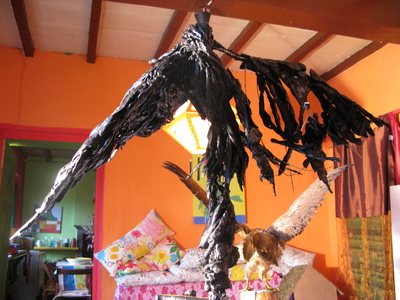
I shake my head and marvel. And not for the first time. This would have been a brilliant sculpture, created in less than a week (though of course the mental conceptualization of these things can take much longer). And, thankfully, I know she can do it again, and better. That’s the benefit of using wax. Think of the poor marble chaps in the Renaissance who usually took months, if not years, to chisel out their creations and they had to live with the constant mental stress that one single misplaced blow of the chisel could shear a wing or an arm off. At least you can bend wax back into place and reshape it should it get damaged. At least unless you physically assault it with a chair. So yes, she’ll try again I have no doubt, and then we’ll take it to London so that Sammy’s ace foundry man and long-term collaborator Chris at Arch Bronze can cast it in metal.. Replacing a wax maquette with an exact replica in bronze through the lost wax procedure is an ancient and incredibly complicated technical skill in itself of course, but that’s another story (See here.)
So that evening, Sammy and Saska and I tuck up in front of some DVDs and I give my wife a hug, promising her that by the end of 2008, at least five people around the world will have heard of her. You’ve got to start somewhere, after all.
Ladies and gentlemen. I offer you Sammy – the Poster Girl for the Barga-News-sponsored Remodernist movement in sculpture. And not only can she sculpt, but she’s got a nice bottom. Today, Aristo’s bar. Tomorrow – THE WORLD!
Bronze Hermaphrodites and the Fat Boy Filter
by Mike Towler
I don’t remember all that much from English lessons in school. I recall that you shouldn’t use very or a lot or exclamation marks in creative writing and that repetition of words in too close proximity is a serious crime against style. I recall snatches of Shakespeare and William Golding. I recall Mr. Shewan dangling me and another twelve-year old – one in each hand – by our hair for talking in the library (My God, he’d be in the Labour Party salt mines these days, wouldn’t he?). One piece of advice I remember very clearly though about writing stories is “Give it a snappy title, and if you can follow that with a decent first line then you’ve got ‘em hooked!”. So how about this one then? Does that title have you wanting more? What do you think the topic is today? Five euros and a lot of cold Morettis if you can figure it out.
[Smartarse at the back] “Go on, it’s about caves isn’t it? You always write about bloody caves. And you know what? No-one cares. Don’t you know that Barganews readers want to learn about jazz, and opera, and what’s happening in Aristo’s bar. There was something in the discussion forum about it a while back..”
I open and close my mouth and narrow my eyes like a fish in a headlight, and an image flashes into my head of the time last August when I brought a big group of students from our Institute on a tour of Barga. Stopping in a little square in the old town after descending from the cathedral, Tour Guide Towler had pointed to his left. “That’s Aristo’s – the bar for cool people.” He then flicked a casual finger to his right. “And that [crosses himself] is the bar for tourists.” I had always assumed this to be so, even though the little bar on the left is so cool it doesn’t have a sign outside saying Aristo’s or anything like that. Inside – probably – are people without first names like Keane the Editor and O’Connor the Award-winning Photographer and Doggybag (can they really all be the same person?). Anyway, out of my crowd Maja the suave Serbian part-time supermodel and Colin the hairy Swiss hippy (blogs passim) end up going left. Me and the other fifteen students go right. It just goes to show. It’s a big problem with being a physicist.
Anyway, defensive now, I glare at the smartarse. I want to say something cool and clever. Instead I say “Er, yeah. It is about caves actually. But look – this isn’t Mr. Nerd’s Speleology News, you know? Are you not aware that my last contribution to this publication described the occasion when my colleague Evans and I had a heroic caving adventure, and we discovered historical relics described in an old book, untouched since the time they were put there in the nineteenth century. Indiana Jones or what?”.
But inside I know – and I know that the smartarse knows – that this story is not like that. Oh no. This one doesn’t have a heroic ending.
This is a lament. A lament for my arse.
The first story, just to delay relating the details of my humiliation, is historical and archaeological. They say this cave was inhabited on and off for five thousand years. So what did these people find to do without Aristo’s? Without Barga, even. Without jazz, for heaven’s sake.
Second story. An adventure. Local guide books tend to have a sentence or two saying that one of the two branches of this cave goes into the mountain for more than a kilometre (although whether it is the left- or right-hand one seems to depend on what book you read, and sadly proper descriptions of cave explorations are very difficult to come by as they only get published in grotty caving club pamphlets circulated to the caver’s mum and a few of his mates. Put ‘em on the internet guys! 21st century and all that..). Well now, in plenty previous trips to Cascaltendine we hadn’t managed more than thirty or forty metres in either direction but not long ago Our Boy Drummond went feet first into a hole near the ceiling down the end of the left-hand branch and discovered a huge secret chamber. Inside a massive vertical wall, and an old abandoned rotten rope leading upwards into darkness. Who dares to follow? In the past, er.. nobody. This time Evans and Towler stand unsmiling at a slight angle to the camera, eyes narrowed, hoping no-one will notice they are flexing their biceps slightly. “We do, by God”.
The Bronze Hermaphrodites
I drew a breath, set my teeth, glanced sideways at the ever-nonchalant Evans who was tapping one of his fingernails on the side of the machine and whistling. Gripping the bronze and crimson leather starting lever with both hands, I slowly pulled it back to its reverse position. Incredibly, the hilltop became hazy and the atmosphere perceptibly darkened. Then the night came like the turning out of a lamp, and in another moment yesterday arrived. The landscape grew faint, then fainter and ever fainter. Yesterday night came black, then day again, night again, day again, faster and faster still. An eddying murmur filled my ears, and a strange numbness descended on my mind. I turned the crystal speed dial to put on pace and night began to follow day like the flapping of a black wing. The dim suggestion of the plateau seemed presently to fall away from us, and we saw the sun hopping swiftly across the sky, leaping it every minute, and every minute marking a day. The twinkling succession of darkness and light was excessively painful to the eye. Then, in the intermittent darknesses, I saw the moon spinning swiftly through her quarters from new to full, and had a faint glimpse of the circling stars. Presently, as we went on, still gaining velocity, the palpitation of night and day merged into one continuous greyness; the sky took on a wonderful deepness of blue, a splendid luminous color like that of early twilight; the jerking sun became a streak of fire, a brilliant arch in space; the moon a fainter fluctuating band; and we could see nothing of the stars, save now and then a brighter circle flickering in the blue.
Watching the instruments, I resolve to stop, and jerk the lever forward again. The whole hideous motion comes to a juddering halt. The solid brass dial reads August 4th 2037 BC. It is 3 o’clock in the afternoon.
Got a job lot of Harry Potter invisibility cloaks and infra-red night vision glasses too. Ebay, eh? Turns out to be have been a good move, because as we peer over the edge of the cliff looking down on the entrance to Cascaltendine we see there are a lot of people here. Cascaltendine is considerably more popular back then. We can hear rhythmic beats and chanting. A bunch of long-hairs are banging on hides stretched over wooden frames, and you know what? It sounds a bit like Gene Krupa on “Sing, Sing, Sing”. There’s even something that looks like a bar, and as we watch, there are a bunch of kids, ten years old or so, apparently being forced to drink something by some older guys and a Chief-Witch-Doctor type with white make-up. They start ‘em early round here, it seems.
Evans and I follow the paths we know to get down off the cliff, circle round, and crawl up the steep approach to the cave entrance from below, then we use our cloaks to get past the band and the dancers and head into the gaping hole at the base of the huge parabolic cliff. Inside it’s quite a bit lighter and more impressive than the last time we saw it in the twenty-first century; in fact there are flaming torches planted in the ground in two long lines all the way to the back of the enormous fifty-metre entrance hall. Someone has even swept the floor. Then, near the back where two narrow passages branch off the main chamber, we see the ten-year olds, flailing now and looking the worse for wear from whatever they’d been given to drink. The shaman guy is shoving them down the left-hand passage out of which runs the magic stream that this cave is famous for. We follow them, trying hard not to give ourselves away by disturbing the water, and we see the boys carried up under the arm of some big guy as he climbs the crack into the upper cavity. We follow discreetly and see them being pushed through the hole that leads into the room which had the dangling rope inside back in our day; clearly we weren’t the first people to discover this place. I hear a splash and howl as one of the kids falls into the pool. The shaman barks some commands in an unfamiliar language – for the sake of argument let’s call it proto-Ligurian – then he walks away leaving the kids in the cold darkness. Unsure what to do, Evans and I settle down to wait.
Zammo squatted on the bare rock, his unclothed back resting against the biting damp rear wall of the cavern. He was staring sideways at the unmoving clusters of elongated caverniculous insects dotted around him and, like all other visitors to the cave before or since, he was idly wondering what they ate and what the point was of flying around small holes in the ground in complete darkness. Being more strongly built than the other two lads he had been able to secure the only ledge where he could sit without effort with his whole body out of the frigid pool that covered the floor of the chamber. Tucka, the smallest of the three, had found an unstable perch on a six-inch rocky projection and was shivering uncontrollably not just on account of the cold but also because of the awful agitation that now gripped him. Even back in the village Tucka had rarely strayed far from his mother’s skirts and the priests’ forced march up to the sacred cave, the overwhelming black drink, and the boys’ subsequent abandonment in this freezing grotto was proving too much for him. The third boy, whose name was Grippa, lay insensible half-in and half-out of the water. Zammo was momentarily unable to tell whether he was alive or dead.
His eyes instead strayed to the flickering flames of the torch held by a piece of twine looped over a stalagmitic spike on the giant fin-shaped rock on the right of the chamber. Gobbets of burnt cloth and tar were falling through the air, hissing as they struck the surface of the water. Zammo knew that the light would soon be gone. Then he gazed at the delicate vertical flutings of the huge flowstone in front of him, looking for all the world like a frozen waterfall, and as his eyes failed to penetrate the heavy shadows high above he closed them and saw again the priest grinding up bark and roots and a black powder he took from a gourd. Strong arms had held them from behind. Each boy forced to open his mouth as the black semi-liquid paste was shoved in and washed down with beer. Almost immediately the boys felt themselves in a waking dream. Now, as Zammo opened his eyes again, the grotto began to spin out of control. Multicoloured sputterings and flashes began to fill his vision.
Suddenly there was a tremendous splash as something heavy fell into the pool. For a fleeting second Zammo seemed to see the lower half of a pair of legs, and heard some spirit voice muttering in some unknown tongue. Something about ‘Haripotta’ then some shushing noises then silence. The proto-Ligurian for “Whoah.. heavy shit” ran through Zammo’s mind. Unlike the others he wasn’t particularly afraid. Back in the village he had known who to approach and who to ask the right questions. He had been told to expect visions and extreme damp and cold and darkness and isolation. It was all part of the Humpa ritual of becoming a man. A day and a night or more in the cave then he would emerge to claim the token of his coming of age.
Then the light went out. The cave was plunged into a desperate blackness like someone had gouged out the boys’ eyes. Despite his bravado, Zammo trembled slightly.
How long they waited they could not tell; any sense of time had left with the light. Zammo began to doze, only to be rudely interrupted by loud howls as Tucka rolled off his narrow perch into the freezing water. The sobbing seemed to take many hours to subside. An aeon later Zammo heard scraping noises coming from somewhere beyond the little hole. A muffled curse as an elbow hit bare rock. A glimmer of light. They were coming.
At the bellowed summons, Zammo put his head into the little hole and wriggled his way upwards, his back dragging unpleasantly through shallow puddles of muddy water. Into the large cavity then into the hole on the right. He knew he was to climb down but he wasn’t tall enough to reach between the footholds, so rough hands grabbed him and passed him down. A bend to the right, over the lip of a small waterfall and into another circular chamber like the inside of a barrel. Left into the long narrow passage with high ledges on either side – Zammo was able to squeeze between them, all the time splashing through the sacred stream that emerges by magic from the middle of the flat-topped mountain.
Finally arriving in the entrance hall he blinked. The rows of flaming torches made flickering shadows jump up and down the wall. Between the torches were long two lines of men, all facing inwards and grasping the hands of the man opposite to form a long arch. The chanting began. A clamorous thunderous rhythmical noise that terrified the boys. Zammo was pushed to the start of the man-passage and he ran through, continually kicked by strong feet in hide sandals, then fell at the feet of the familiar figure of the priest waiting at the end. The looming figure smiled kindly through his white mask and held out a small bronze figurine. With unfeasibly large testicles.
“Boy – you are now a man. Here is your gronk.”
Boggling slightly, Evans and I decide we have seen enough and head off down the hill. We pass the outer wall of the fortification – not the same as the giant wall that exists in our day but you can see where they got the idea. I glance up the cliff to the right. Sure enough there is the entrance to the Palace of Ismeno, and amazingly there are people inside! The wild fig tree in front of it is much larger than in our day and ladders are lashed from the upper branches up to the high ledge. Two guys are apparently acting as lookouts and a strange blond woman is eating some legumes. I grin and shake my head – hard luck Aleksandra. Evans and I return to the Time Machine, once again I push forward the bronze levers, and not long afterwards we are in the warm sunshine of the summer of 1972. As we peer over Cascaltendine’s now ruined retaining wall I hear a familiar sound. No, it can’t be – it’s Misty Mountain Hop off Led Zeppelin IV – playing through a hissy battery-powered tape recorder. We then hear digging noises. The clink of metal on metal. A long-haired thin man from the University of Pisa is sifting some soil taken from a silted-up natural basin; he reaches into the sieve and plucks out an object. The crumbs of earth fall away. A figurine! The man’s figures brush away some of the earth. A green patina. Bronze. “Paolo! Vieni qui – ho trovato qualcosa..”
Michelangelo Zecchini – for it is he – is carrying out the first serious archaeological dig in Cascaltendine in the mid 1970s with his mate Paolo Mencacci. He has just found a 4000 year-old bronze hermaphrodite idol (which Zammo had known as a gronk). This was only the first of a great cache of similar figurines. They also found fragments of Greek kylixes, Roman coins, vast number of animal bones, and quantities of other things which showed the place to have been used or inhabited over millennia. This is my translation of the abstract of the paper they subsequently wrote about it:
“Excavations carried out at the Cave of Castelvenere in the province of Lucca have brought to light archaeological remains from various epochs datable from the second millenium B.C. up to the first centuries of the Christian era. The objects discovered suggest that the cave was the scene of cult activity – a conclusion supported in part by the recovery of a number of unusual bronze figurines of great antiquity, all either female or hermaphrodite.”
For what it’s worth I’ve translated the whole article into English, and you can find the result here but just so you don’t have to read it let me talk, superficially, about some of the basic issues.
The Humpa were the ancestors of a people known as the Ligurians or the Apuan Ligures who clashed with the Romans in the time of the Republic and afterwards, and were forced to hole up in places such as Cascaltendine (a bit like Helm’s Deep in Lord of the Rings, hence the big wall). Now of course these people left no written records and normally all we can do is overinterpret things from objects they leave behind. However unlike their contemporaries the Etruscans who left behind art and jewellery you’d be proud to wear to parties today, the Ligurians were quite frankly a bit crap – and quality objects like the Cascaltendine bronzes are pretty unusual.
Up to now no-one has been able to say what the gronks were used for or why they were made. Well, they didn’t have a Time Machine did they, and as part of our contribution to original research on this issue, Evans and I can reveal that they were given to members of the tribe in a ‘coming of age’ ceremony and that thereafter they were the receptacles of the soul of the owner. The little spikes on the bottom were used to stand them up in some appropriate corner of the house. The hermaphrodite ones with huge testicles were for the boys (not sure why they had breasts but there you go – probably some kind of perverted fetish) and the female bronzes with carefully-engraved private parts were for the girlies. As it happens a cache of unused gronks (they had to make them in batches, you see) were left behind in the cave when the Humpa were forced to flee following an invasion of the valley by the fearsome Oompa-Loompas and these were the ones found by the Pisa boys four thousand years later. Oh yes.
The relationship of prehistoric Italians with caves is well described in a fascinating book called Underground Religion: Cult and Culture in Prehistoric Italy by UCL Professor of Archaelogy Ruth D. Whitehouse (Get it at Amazon.com..). One thing she makes clear is that prehistoric fellows loved caves associated with what one might call ‘special water’ – be it waterfalls, steam caves, caves with natural fizzy water, underground lakes, or in the case of Cascaltendine mysterious streams appearing out of nowhere. Usually these places seem to have been used for religious or ‘cult’ purposes and although Cascaltendine isn’t mentioned in Prof. Whitehouse’s book it has all the hallmarks of a special water cult cave. Our time trip now seems to have confirmed that.
Anyway, there’s a long discussion to have about this but the Towler blog isn’t the place for it (for all I know Cascaltendine scholarship has moved on since the 1970s article but the relevant journals aren’t easy for me to get hold of). Read my translation of Zecchini and Mencacci’s article or Ruth’s book for more professional insight; go to the Villa Guinigi museum in Lucca to see some of the gronks. But just before we get on to the adventure story, it’s interesting to note that Pietro Magri – whose little nineteenth century book initially sparked my interest in Cascaltendine and whose chiselled initials and rope Evans and I found in the Palace of Ismeno – had this to say just before leaving the cave back in 1880:
“There was nothing left to see, but I knew it was bad to go back home without taking with me a memento of the Tana di Cascaltendine. I therefore took up a mattock and set myself to digging to see if Fortune would be kind to me, and in fact after excavating perhaps two handfuls of earth I found myself looking at some kind of black object.. I picked it up and examined it; it was.. a bone!”
“Our Diori burst out laughing, perhaps with good reason. For my part it seemed that Fortune had in fact been very kind to me, and I treasure it. I still do not know what it is, I cannot decide, but it certainly has the shape of a human bone and perhaps we will be able to say something about it subsequently.”
If only he had kept digging..
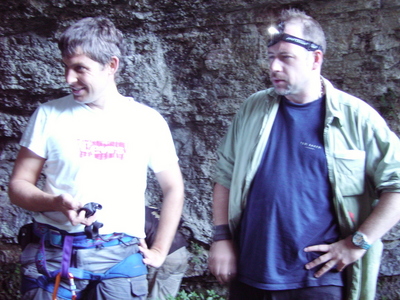
Following our return to September 2007, Evans and I go back to the chamber where we watched Zammo and his friends 4000 years ago. We are no longer hindered by the Time Travel Prime Directive (“Don’t let ‘em see you, and above all don’t kill anyone.”) so we can now attempt to progress further into the cave. You know, you hear about the Grandfather Paradox but you’ve only got two grandfathers and they’re pretty easy to avoid if you don’t want to shoot them. In 2000 BC – 160 generations ago or whatever – you have in principle 2 to the power of 160 (=730750818665451459101842416358141509827966271488) ancestors. This is just a tad less than a good estimate of the number of atoms in the earth, so you’re pretty much related to everyone (just goes to show the extent of inbreeding though!). And of course you don’t need to go around slaughtering everybody to affect the future. If you accidentally cause someone not to meet his girlfriend that night because they’re too busy gawping at the weirdo time travellers then the long chain of your ancestors will get broken and you will vanish in a puff of logic. Risky business. Doctor Who must have nightmares.
Anyway Evans and I are standing on the small ledges at the edge of the pool that covers the base of the chamber. At the other side of the pool we see the huge fluted flowstone structure erupting out of the water and curving upwards. Dangling down the middle of it is the old rotten rope. Who left it there is impossible to say but clearly it could have been here for decades. Between us we only have two harnesses and a nice modern pink rope, so someone is going to have lead up a wet wall without protection; you can’t trust old rotten ropes not to break when you put your weight on them. I’m certainly not going to trust my weight to it. I have a wife and baby. Luckily however, Evans – who has a wife and four babies under the age of five – is an absolutely insane suicidal lunatic and he plunges into the pool, wades over to the wall and starts to explore the possibilities. Even more luckily, as we look around we see that over on the right there are some footholds and handholds which might enable him to stick to the wall and avoid testing the shock loading of the ancient cord. It seems, possibly, that it will go.
Just because he can and probably ought to, Evans ties the old rotten rope into his harness. Stepping up out of the water, with the nice but currently useless pink rope trailing behind him, he places his sodden boot onto a small rocky protuberance at the base of the wall and begins to climb. One hand up. Second hand up. Second foot out of the water. Onwards and upwards. Past the point of no return where he’s going to really hurt himself if he slips. I wonder if it will be possible for me to get him out of here if he breaks both his legs? Remembering the narrow holes one has to wriggle through and the walls you have to climb just to get to this point, I think not. I make the problem easier by avoiding thinking about it any further, and instead I wonder whether Samantha and I could cope with four foster children on top of the one we already have. Anyway, Evans continues upwards, sticking to the rock like one of those absurd cave insects that you still see even down here (what do they find to eat, I wonder?). Quickly, assuredly, he makes his way towards the curving summit of the flowstone about 50 or 60 feet up where hopefully he can find a safe stance. At his confirming shout I feel weirdly relieved..
The pink rope snakes down and I clip on. My turn.
It takes me a few moments to attach myself to the wall with my whole body out of the water. It feels strange to be doing a serious climb again, fifteen years after doing the Avon Gorge under the Clifton Suspension Bridge, and a bit of dabbling in Liguria a few years after that. I get up another metre or so and see immediately that the next bit is tricky. Evans had seemed to breeze through here, but then again he’s a better climber than I am. Inexplicably it takes me several minutes to put together the appropriate combination of moves (when in doubt just try to move a few inches higher and solutions will reveal themselves). I’ve never had problems in trusting equipment and Evans is reassuringly keeping the rope tight above me (it seems there is a kind of ‘natural bridge’ rock formation around which he has been able to loop the rope). After a few more minutes of scrabbling I am level with Evans, and all too aware of the hideous drop into inky blackness behind me. I focus on looking straight ahead and working out how to get off the exposed wall and deeper into the mountain. Evans, who has already found time to do some reconnaissance, disappears into a smallish opening up and to the left.
Splashing and grunts can be heard. The next chamber is evidently wet. When it comes to my turn I poke my head through the opening and groan. The small space beyond is like the inside of a dog kennel and a foot deep in water with another very restricted opening exiting to the left. Evans has squeezed through and has reached the next chamber and he exclaims in pain as he stands up and cracks his head on a protruding fin of rock (of course we didn’t bring helmets). I twist around inside the kennel and struggle to angle my body correctly to make the exit while trying to avoid dipping too much of my body into the freezing water. As my head emerges through the second opening, my torch illuminates the walls of another second relatively dry chamber with a proper horizontal floor and finally I begin to feel safe.
We look around. A large, unusual chamber. Near the back, part of the wall has collapsed and it is clear that it is not solid rock but something like gravel covered by a centimetre-thick layer of limestone concretion. There are some unusual rock formations around the area above the opening we have just come through but at first glance there appears to be no way out. It takes thirty seconds or so to see an exit hole high up amongst these formations. Evans is up like a rabbit (one that knows how to climb, obviously); he squeezes through and immediately calls back. “There’s writing on the wall, like.” I haul myself up to the opening – it turns out to be like a small ship’s porthole – and I poke my head and upper body through. Sure enough, in front of me there is an inscription on the wall – a date in the 1930s and a name (I forget what it was – when you’re as senile as I am I should have remembered that I need to write things down.). I wonder idly if this was the owner of the rotten rope – my God – Evans could have been trusting his life to something eighty years old! Looking straight ahead I see there is a great crack in the rock heading more or less east as far as our torches will go. To the right another passage bends out of sight. This is more like it!
I’m excited now we finally have something new to explore (I had been to the frozen waterfall cave many times before we dared the ascent) and I push forward eagerly. I wriggle another foot or so through the tiny hole but suddenly I come to a dead stop. I wriggle some more. And some more. I twist and contort my body to get the correct angle. An awful realization hits me, and I begin to turn ever so slightly pink.
My arse is too big to fit through the hole.
For a man whose personal self-image is still that of the muscular young runner of fifteen years previously, this is a hard blow for me to take. I move my gaze up from the floor towards the far wall, where Evans is leaning nonchalantly against the rock, staring at the strange Johnny Eck-like figure in front of him. As I look into his eyes, I realize that we are both thinking the same thing. If I get stuck, he will be trapped by a human-shaped plug in the Fat Boy Filter and I will have to watch him die of starvation whilst continually having to apologize for weeks on end. If he has brought a knife, he will have to dismember me in order to stay alive. If he hasn’t, he’ll have to chew his way through.
Immediately I stop struggling forward as my arse is now jammed in tight. I try to go back but the fabric of my trousers is all rucked up, and I have to wriggle for several minutes to free it. I reverse for a foot or so. Relieved and assured of his exit, Evans says he will quickly explore the new passages but it is clear that the enthusiasm has gone from both of us and we agree that given the impossibility of rescue he shouldn’t go too far. He disappears round the corner. There are scraping sounds then silence. For no particular reason I reach upwards and turn off my head-torch. Instantly I am in utter blackness and I have an overwhelming feeling of smallness like that guy in the Restaurant at the End of the Universe. I am a tiny ant compressed into a tiny hole under billions of tons of rock of a giant table mountain. A tiny ant. With a big arse. Flushed and humiliated, I settle down to wait.
When Evans returns, we say little. He is unenthusiastic about what he has seen down the unexplored passages but it seems there are still new ways to go which will have to wait for the future. We both struggle through the flooded dog kennel and emerge at the top of the frozen waterfall. Both my nice pink rope and the 1930s special are looped around the natural rock beam above us from where they will be difficult to remove. We agree to leave my hundred-quid rope here to help future expeditions (though there is a reward of two Moretti beers for anyone who can arrange its safe return to me – now there’s a challenge).
We decide that I should descend first, and as I contemplate what needs to be done I feel my first real moment of serious apprehension. See, the top of the waterfall is not a proper ledge with a flat top and ninety degree angles. The smooth slippery rock simply curves over into a giant black void which our headlamps don’t seem to penetrate. In a wonderful optical illusion there are no hand- or footholds whatsoever. The words “Not sure I can do this” escape my lips before the idiocy of the expression becomes apparent to me. The moment passes and I remember to have confidence in the equipment. I’m on a rope now. But it’s not the best moment of my life as I slide forwards on my big arse with my feet disappearing over the curving edge desperately looking for something to clutch before the friction is no longer sufficient to hold me.
I take one last look backwards into the shadows wherein lies the hateful Fat Boy Filter, and I think of all the lovely dinners at Mulino and Da Sandra and Rondine and that nice place in Vallico Sopra that I will have to miss, and the amount of bloody running I will have to do to get through that hole. And you want to know the expression on my face at that moment? Well, I tell you. Sullen ain’t the word.
The Palace of Ismeno
by Mike Towler
“Can you see the carving?”, I call from the base of the ladder.
My English friend Huw from Benabbio peers over the lip of the cave forty feet up the cliff and grins. “I think you should come up here and have a look.”
Actually, and I apologize for breaking up the flow of the story already, we’re not going to call him Huw. Some Italians might read this. And while they have many virtues, Italians are generally not capable of pronouncing the letters H and W, so this is something like the worst word in the world. When called upon to say it most of them grimace slightly, eventually splutter something like “Urgh..” and then throw up their hands in resignation. So let us, as they do, call him “Evans”.
Anyway, Evans beckons for me to ascend the ladder. It’s quite a construction. The previous year I had a bunch of visiting physicists drag the twelve-metre ladder I bought to work on the roof of our church – the longest they had in the DIY store – all the way up here but it was a couple of metres too short to reach the cave. This summer I call Evans, who fixes things. He’s a problem solver. His response was to strap his telescopic ladder on to the end of mine, and now it’s long enough. It looks pretty terrifying, but we’ve secured it with a rope and now it seems stable enough.
Evans has just climbed it. He has entered the Palace of Ismeno. As far as I can tell, he’s the first person to get up there in 127 years.
Here’s what Barga priest Canon Pietro Magri had to say in his book An excursion to Mount Gragno and the cave of Cascaltendine, on his approach to this spot in the year 1880:
And what a beautiful sight! The wide entrance to the cave opens up at the base of an enormous hollow in the mountain which has the general shape of a parabolic curve, though this is somewhat irregular and imperfect lower down on the left-hand side. The upper edge of this great cavity is the edge of the summit plateau of the mountain and is garnished with holm oaks.
That’s Cascaltendine itself, which is easily accessible and well-known and which I may have mentioned in er.. both of my previous contributions to Barga News (I’m really not obsessed with caves, OK? I’m just working this through.). Anyway, this article is not about that. However if you stand in front of Cascaltendine, look up to the left, and track your eyes around the giant overhanging cliff then according to Magri you see “a hole of considerable size some way above a wild fig tree“. It’s not obvious and you probably wouldn’t see it if it wasn’t pointed out to you, but it’s there. That is the Palace of Ismeno. That’s what we’re doing today.
Magri goes on to say that Bertacchi, a gentleman who published the first description of Cascaltendine sometime in the 1700s “was not able to investigate this hole on account of not having any ladders, but it was visited by members of our party and Ferruccio Salvi has communicated the following description to me.”
Salvi’s prose style is not up to that of the priest, and there follows a somewhat leaden description (see later) which ends:
Before coming down from the cavern we used a chisel to inscribe our initials and the year 1880 on both walls of the passage near the entrance.
Magri continues.
A most curious thing at this point was the sight of people appearing at the mouth of this barren and empty cave at such a considerable height. This was a most astonishing spectacle and we were able to enjoy the effect at the very moment of Diversi’s appearance at the hole. We called out to him as he popped out with a cap on his head, wearing glasses, with a mattock in one hand and a piton in the other, but it no longer seemed to be him; there was something strange, something fantastical, something idealized about him. [My brother] Magri, who went up there and saw him inscribe our names, painted a verbal picture of him as a kind of wizard. The idea never went away and our friends christened the cave “The Palace of Ismeno”.
Ismeno being the counsellor and wizard of the King of Jerusalem who stars, for example, in Tasso’s epic Gerusalemme Liberata and, later, in Milton’s Paradise Lost. But of course you knew that. Obvious required knowledge for your sophisticated man about Barga in 1880.
Anyway, some years ago I was shown a tattered copy of Magri’s very rare little book that lives in a drawer in our neighbour Delma’s dining room table. I ended up translating it, and conceived the idea of writing a little photo essay for our website, matching up the descriptions in the text with the current reality. That was all fine, except that I had no way of getting into the Palace of Ismeno. In 1880 Magri simply hired some big guys with big ladders from Cardoso, but I couldn’t do that. How then could I see if the chiselled initials were still there?
Well here we are – it’s Friday 3rd August 2007 – and Evans and I are at the cave with ten quantum physicists from around the world who are attending a summer school at my Institute. Now your average quantum physicist is not normally considered essential equipment on a tricky mountaineering expedition but today we have heavy gear to get up to the sheer rock face, and Evans and I are grateful to the quantum Sherpas for helping to carry it.
Way up on the ledge, Evans’s expression tells me that there is something to see. I grasp the ladder and head upwards. The ladder flexes alarmingly; the rock on which it leans is crumbling and unstable. Forty feet up I step over the parapet. I become aware of a dark, dusty passage, higher than a man, descending into the heart of the mountain. Evans gestures to the right hand wall. I see a piton battered into the stone, an antique rope still attached it. Above it and to the left, chiselled into a low rock shelf, in letters four inches high: D.P. MAGRI 1880 BARGA.
On both walls, Magri said. I look to the left. Less clear, but there’s an inscription. Blowing away some of the dust, I see: DIVERSI, SALVI 1880. I nod. He didn’t make it up – that’s what we came for. Flash. Flash. Photos.
It’s time to explore, and we set off down the passage. After a while the ceiling comes down low and we crawl on our hands and knees through the dry dust. There is a junction. It is then I realize we only have one hand lantern between us, and that somehow, stupidly, we have left the head torches at the bottom of the cliff. Colin and I wait in total darkness in the inner chamber as Evans and the others head back to the entrance to retrieve the equipment. If my mother didn’t read this, Colin and I would have communed with a cigarette whilst we waited.
Presently the others return, the beams of their head torches made visible by the clouds of smoke billowing in the confined space, and I fish out a battered copy of Magri’s book from my back pocket. I read aloud to the others the text of Salvi’s report which Magri quotes, speaking quickly as I pass through the dull bits:
The entrance is, when facing outwards, to the right of the principal cavern around 12 metres above the level of its floor. It proved necessary to overcome this difference in height by means of a ladder, as the sloping wall containing the entrance is almost vertical and in consequence inaccessible without the ladder.
At its mouth the cave is 2 metres and 20 centimetres in height with a width of 1.80 metres, but 8 metres inside the ceiling has descended to only 0.90 metres and henceforth it is necessary to proceed on all fours to a distance of 23 metres from the entrance. The initial breadth of 1.80 metres reduces, 8 metres along the passage, to just 1.50 metres and stays that way until the 23 metre point mentioned above, where the cave is 2 metres broad and 1.60 metres high. This is a good place to rest since even though one cannot stand up completely, those of limited stature may, by inclining their head slightly, stretch their back and straighten their knees.
I note this is where we are now.
Beyond that point the cavern divides into two branches. The passage on the right descends rapidly with a gradient of 40 percent; the one on the left has a 30 percent upward gradient.
After 4.60 metres the first passage leads to a little lake at which point the cave ceiling descends to within only 60 centimetres of the mirrored surface of the water. This is matched by the depth of the lake and so the total distance from ceiling to cave floor is only one metre and twenty centimetres. Proceeding beyond this point is exceedingly painful, for although the water only comes up to the level of the knees one is obliged to maintain the back bent almost horizontally. Moreover the water is exceedingly cold and indeed almost freezing even in summer. Nonetheless, as we wished to know if new passages existed beyond the lake one of the guides was persuaded to try to pass this obstacle and he succeeded, though not without some fatigue and discomfort. After proceeding another 6 metres and happening upon the other side of the lake, our explorer found a sudden elevation in the ceiling which permitted him to stand up but 1.20 metres beyond this point the chamber came to an end.
Those who enter the left-hand branch may like to know that it is a metre in height with a breadth of 0.90 metres. One must climb, as I said, up a 30 percent slope and 3.10 metres inside the cave bends sharply to the left where unexpectedly we encountered a great abyss in the floor, providentially made visible by the light of our lamps. We threw a stone into it and immediately heard the splash of water.
One of the guides undertook to climb down into this sinkhole, where the damp walls – only 0.8 metres apart – allowed him to support himself by pushing against them. As soon as we saw his head disappear and had lowered a lamp to provide him with light, the guide told us that he was touching the water with his feet and immediately afterwards he found the bottom.
While the walls of this well were being examined, one of us happened to be still at the edge of the pool in the right-hand passage described above and he observed that he was able to see the light of the lamp held by the man in the hole. In this way we discovered that the two branches of the cavern were in fact connected through an extension of the little lake as far as the sinkhole in the left-hand passage.
This whole cavern is clearly undergoing a process of natural enlargement through the action of the waters, which presumably flow into the lake through the vault of the sinkhole and then exit through the cave mouth. Both the floor and the walls which curve down to them show obvious signs of erosion, and this is without doubt produced by the action of the water which in times of heavy rain must infiltrate the little lake, raising it to the level of the highest point of the cavern whereupon it discharges through the entrance.
The rock in which the cave has formed is the usual Albarese stone [an expensive ivory-coloured local limestone used e.g. for the facade of Barga cathedral] – carbonate, that is, limestone from the Cretaceous epoch perhaps with some Pleistocene character though as we were unable to recognize any traces of fossils there must remain some doubt about this.
Before coming down from the cavern we used a chisel to inscribe our initials and the year 1880 on both walls of the passage near the entrance.
Ten minutes of exploration show us that sometime during the previous century and a bit the underground lake has disappeared; whether temporarily on account of this summer’s dry weather or permanently is unclear (Magri was here in late September). Magri’s supposition that the two passages are connected turns out to be correct, and we are able to crawl down the sinkhole in the left-hand branch and end up near the lowest point of the right-hand one. Just before I get back to the junction having traversed this loop I find Evans. He is waiting for me. He is determined I should do something first today and he points out that as the cave was flooded on the only known previous visit I could be the first person ever to complete the full circuit of the two branches. Oh yes. Bow. Elvis impersonation. Thank you very much.
Back at the entrance, Evans, I-Chun, Hamad and Colin in turn step over the parapet high in the air – some with more confidence than others – and descend the ladder back to base camp. I begin preparing to follow them, but then I see that some of the other guys want to come up here. Matus Dubecky – the first Slovakian tough guy to visit the cave – arrives. Then Amit Raj Sharma. The first Indian Professor. Then Aleksandra Vojvodic and her ‘husband’ Jonas Hartwig. The first Swedish vegetarians. And finally Mikhail Kibalchenko. The first Russian. Maja Stojkovic and Dan Fors, apparently not being slightly mad, seem happy to sit at the base of the cliff.
I hadn’t really planned on bringing them all up here, but the students seem excited to be doing something slightly dangerous. In today’s risk-averse world, you can bet that there are some of them who have never been allowed to sneeze without a safety rope. Maybe today will be thrilling for them, maybe it will be scary. I just hope we don’t kill one.
Anyway, after a little more exploration we evacuate. I help the last group of students to descend without incident and I am left alone in the Palace of Ismeno. Remembering Diversi, I ask Evans to take a photo of me from the ground. As he lifts the camera, I wonder how best to look like the wizard of the King of Jerusalem. Realizing that I don’t know, I shrug, and in the absence of a mattock (whatever that is) I wave a tiny hammer. As I step off the parapet, I wonder how long it will be before someone makes it up here again..
As I touch the ground I affect insouciance. “Well, quite a successful day all round, don’t you think?” I say breezily. Internally I immediately remind myself not to say things like that till later, it being a well-known fact that ninety per cent of mountaineering accidents happen to cocky people on the way back down. And, sure enough, as the ladder is being pulled off the rockface there is one plan in my head to get the thing horizontal on the ground, and the three other guys helping me turn out to have three different plans. Before I can impose order a shower of rocks gets dislodged from the crumbling parapet, and a largish one smacks into Amit’s head. He’s wearing a helmet, and gets away with a bruised arm, but clearly we’ve been lucky. Cursing inwardly, I pretend everything is OK and tell everyone this sort of thing happens all the time, but I’m annoyed. It takes the gloss off the day.
As we manhandle the heavy ladders and equipment back down the precipitous slope that leads down from Cascaltendine back to the main path, I begin to reflect on Magri’s final words concerning the Palace of Ismeno back in 1880:
The people around these parts say that in former times there was a wild fig tree, rather taller than the one we see today, which the local boys could easily climb in order to get into the upper cave. Now one most certainly cannot reach it without the aid of a ladder. There are others who say that the wall we have described was once of such a prodigious height that people could climb up there, but as we could observe no vestiges of masonry near the cave we cannot really assert anything in this regard.
I don’t believe the thing about the wall (though what remains of it is ancient, impressive and mysterious) but it occurs to me that if some of these eighteenth century local boys were Chinese or Moslem or Swedish vegetarian immigrants then some of the entries in my long list of firsts above are not really true. It’s also possible that Speleoclub Garfagnana have their Annual General Meeting and Official Club Orgy in the Palace of Ismeno every September, but I really couldn’t see any evidence that this is the case. No graffiti apart from Magri’s, no artefacts apart from a ring off a pigeon’s leg (how long does it take a dead pigeon to disappear completely?), and none of the usual speleo paint on the walls. In the absence of any evidence, it seems likely that we’re the first people here since the nineteenth century. At any rate, until the readers of Barga News tell me different, that’s what I’m going to say.
Finally then, as I trek down the hill, I glance at my watch then slap my forehead in annoyance. It’s 7.45pm. Understand that, following the serious business of the mornings at our Institute schools and workshops, we like to organize various simultaneous group activities in the afternoon. The active athletic people we send to climb mountains and canyons and to explore caves and to do other healthy activities such as swordfighting. The unhealthy lazy people, by contrast, get driven to sunny swimming pools where they rub sun cream into each other’s fat lazy arses whilst eating huge tubs of ice cream and drinking gallons of beer (at least I assume that’s what they do). All the various groups then meet up in the evening at some restaurant to eat (again, in the case of the lazies). Today, as I realize we’re going to be at least an hour late at the rather lovely Mulino in Fabbriche di Vallico, I also recall that my wife Sam is in the lazy group and that in our family lateness is punishable by death. I gulp, and as the sun begins to set on another adventure in the Apuan Alps, it becomes clear that the most dangerous part of the day is yet to come.
First Post
by Mike Towler
So I’m standing at La Croce, contemplating all the little houses sprinkled about the Middle Serchio Valley far below. I’m perched on a rocky platform jutting into space about two-thirds of the way up the sheer front face of Monte Penna and a few miles to the North, smothering the summit of its own little hill, I can see Barga, home of barganews.com. As you’d hope someone has carted a huge metal cross up here, and I’m holding on tight to it as it’s a hell of a long way down and the wind is blowing my hat off.
I turn round and make my way back to the main path where I go right and head north again. I’m looking for a cave. Not the Tana di Cascaltendine, well-known and about ten minutes behind me, but another one. See, on a wooden hoarding in San Luigi, there’s this rough map of the Turrite Cava valley and dotted all over it are caves (the circular black and white splotches):
Two others caves exist in Mount Gragno (he means Monte Penna) above the Fosso di Bolognana, one of which was visited by some of our party including Ferruccio Salvi. He has made a sketch plan of it which he has kindly forwarded to me along with the two sketches in this pamphlet, and we hope to publish a description of it in the next summer season.
As far as I can tell no such thing was ever published and so after more than a century I thought I’d have a look for these other caves. There’s two of them marked on the display board in San Luigi car park. I’m interested in the one I’ve marked with an arrow (the one next to the green number 2 is on private property and I don’t fancy getting shot today):
I’ve got a couple of proper maps of this area from proper map shops that show this cave but the maps are completely different from each other and from reality. I picture the surveying guys “Uh.. yeah. We did that area, boss. It kind of looks like this” handing over the made-up sketch they scribbled down in the pub because they couldn’t be arsed and they never quite figured out how to handle a theodolite.
Anyway, one of the maps has got the cave sitting at the top of a stream bed. There’s no obvious ones, so I pick a depression in the ground that could have been formed by running water and head up. The slope is steep and it’s an uncomfortable scramble up a mess of leaves and loose soil. I get close to the base of the upper cliff. Nothing. No cave. But then I realize that to the left there’s something like a path climbing upwards. It’s got to be the one that heads up onto the summit plateau of Monte Penna. I tried to find that last year trying to get down off the plateau from the other direction, and the undergrowth was so thick I couldn’t find it. So I figure what the hell – might as well explore something today. Sam said I had to be back in two and a half hours or she would call the police (she worries like that).
The sun is pretty low in the sky – I reckon I’ve got about half an hour’s daylight left. Rather than retrace my steps or go round the regular footpath at the base of the cliffs to the north I decide to head up the overgrown and maybe long-abandoned path, get up on the plateau and see if I can fight my way through to San Luigi, from where I can get down the road to where I left the car in five minutes or so.
Nice move though. You really don’t want to get lost up there at night without a torch. It’s overgrown like the Amazon, on three sides of the plateau there’s huge vertical cliffs that you can walk straight off in the dark, and these days nobody ever ever goes up there.
Let’s go. A big old tree has toppled over and slid down the hill, blocking the path. I have to climb up and around. A disturbance down below to the left, and there’s a family of three wild boar crashing through the undergrowth. I bet they haven’t seen a human for a while. It’s the first time I’ve seen them in the flesh apart from on my plate, though sometimes you can hear grunting and crashing noises from far-off parts of the forest. I finally get to the plateau where, helpfully, the path disappears. Somewhere behind Monte Matanna ten miles to the west the sun is plunging into the Mediterranean and gloom is gathering. I start to jog.
I figure that as I know the other side of the plateau pretty well I just have to keep going west and finally I’ll find something I recognize. After ten minutes I stumble upon the clearing where somebody is growing dope plants because like me he thinks that nobody ever goes there. Relieved, I head over to the path I know leaves the clearing to the west and follow it. I go past the old ruined metato which belonged to our neighbour Delma’s family when she was a little girl. I get on the main track and ten minutes later I’m at San Luigi. This is an old pastoral hamlet – current population around ten – which is the highest place you can drive to on the road from Fabbriche di Vallico. I start to run down the road from San Luigi towards our car which is waiting at the hairpin bend in the road from where you take the Cardoso footpath – the one that goes down past the Cave of Cascaltendine and on to La Croce. Before I get there in the last few minutes of daylight I linger at the point on the road where the panorama of our new world is laid out underneath me. First the village of Vallico Sopra – the church of San Michele curiously apart. A few hundred metres down from that is Vallico Sotto – our village, where Sam is waiting – and way below is the bottom of the Turritecava valley where the local metropolis of Fabbriche di Vallico lies hidden behind a ridge.
My eyes focus on the highest building in Vallico Sotto. Despite the gathering gloom I can see that the roof has a lot more moss than neighbouring buildings and it needs a bit of work, and there is a cross and an old bell on the ridge beam. That’s our place. This is, or was, the Oratorio del Santissimo Crocifisso. Il Collegio. It’s been there for half a millennium, at least. It has served as a monastery, a church, a hospital, a school, and the Lord know what else. For the last few years we’ve called it the Towler Institute. When we’re dead and gone somebody else will call it some other name.
So I get in the car and I roll down the road, park up in Vallico Sotto and crawl up the steep hill up to the monastery. I’m a minute late. The most on-time I’ve ever been so I escape a scolding. I’ve failed completely to find the cave – again – but that’s OK. One of the problem with finishing quests is that you then have to think of another one.
So anyway, that’s enough of that. From now on, let’s say once a fortnight or so, if anybody turns out to give a toss I’ll be posting “News from the Towler Institute” here courtesy of barganews.com. Let me start by telling you something about it. Sammy and I bought the place in August 2004 (Poor Gordon died and left me a little old falling down house near Bolton, and what with property prices being what they are, I swapped it for a Tuscan monastery. Makes you sick doesn’t it.). For those of you who remember the old Art School Il Collegio (see Barga News archives) – it is, or was, that. Now the website says “The Towler Institute. Science research centre, art studio, conference venue, cinema. The place to be in the Apuan Alps”. All you need to know really. We’re trying to make it into a place where curious people from around the world can come to discuss or talk or learn or do other fairly serious things. In the mornings. Then in the afternoons we use our local knowledge to take them on fabulous activities in the mountains and we take them out for fabulous food in the evenings. Because my main job is in theoretical physics research at an English university we’ve begun, in the first couple of years, by trying to organize scientific conferences a little bit different to the usual ones, and by hosting quantum physics summer schools (oh yes). The response. Things like..
“It was easily the most enjoyable conference I have ever attended, and in the most beautiful location”
“Each of the days in Tuscany was amazingly wonderful, can I ever imagine Italian lovely place without any crowd of Japanese tourists?” [from a Japanese person]
“It remains for me the most profitable workshop I have ever had, associating the top quality of lectures and the excellent practical training, making very difficult things to become accessible. It remains also for me the type of ideal ambience associating work, scientific discussion and entertainments.”
..so I hope we’re doing something right. And the future? The church attached to the Institute is fully equipped for film projections on its massive screen (I don’t know how many cinemas there are in the Apuan Alps, but here’s one for starters. All the Vallico people came round for the opening night party last year featuring – what else? – Cinema Paradiso, and the local little boys keep asking me to do it more often). We can also hold concerts (rising opera star Antonio Badinksi did a damned fine impromptu performance there last year). And, of course, my wife Sam – and she’ll hate me for saying this – amongst her many talents she is one of the best fine art bronze sculptors that I’ve ever seen, and she also draws amazing pictures based on sacred geometry. This summer in the church she’ll be making her latest pieces commissioned by various new buildings and public spaces in London. Only trouble is, Ryanair’s goddamned 15kg weight limit.. How the hell are we going to get them back to England?
I also want over the next few years, mainly through Italian translations with a bit of research on the side, to produce some information in English about the history and geography of the Apuan Alps and the Garfagnana. As there isn’t much of this about, I’ll put it on the Institute web site. Criticism invited and welcome (I only play at translations – you wouldn’t want to hire me professionally). For what it’s worth, see here for what I’m currently working on.
Finally and before you ask – who the hell said I can name an Institute after myself? Don’t I have to be dead first? The name started off as a joke invented by one of our friends when we were setting it up, and it kind of stuck. Maybe if I fall off a cliff one day while looking for caves it will all seem horribly appropriate.
Anyway, I’ve gone on too long. If anybody got this far let’s finish this with a couple of questions:
(1) I realize this must sound really dumb to all the local speleological chaps, but has anyone got any idea where this damned cave is?
(2) I have at least two large groups of quantum physicists and a bunch of Cambridge University politics students coming to the Institute in the summer and we need to entertain them. I’m looking for challenging fun activities which might just do that. See Things to do in Vallico Sotto on our web site for my suggestions so far. I’d love to hear from anyone with any similar ideas.
That’s it for now.
